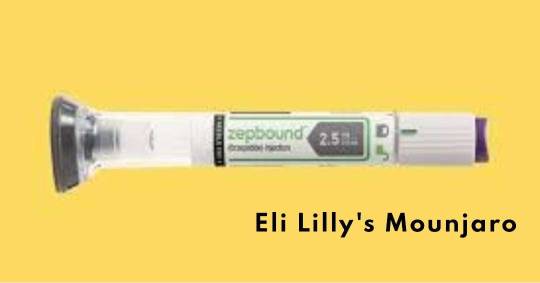Text
FDA Approves Eli Lilly's Diabetes Drug Mounjaro for Obesity as Zepbound: New Weight Loss Treatment Option Available


What is Zepbound and Mounjaro?
How Does Zepbound Work for Weight Loss?
Impacts of FDA Approval on Diabetes and Obesity
Comparing Zepbound with Other Weight Loss Drugs
Understanding Eli Lilly's Role in Diabetes and Obesity Treatment
When will Zepbound be available?
Who is eligible to take Zepbound?
what do you need to know about Mounjaro? ( Zepbound )
The Food and Drug Administration (FDA) has recently approved Eli Lilly's diabetes drug Mounjaro for obesity under the brand name Zepbound. This significant development has sparked interest and raised hope for addressing the unmet medical need for obesity treatment. Zepbound, containing the active ingredient tirzepatide, offers a new approach to chronic weight management for people with obesity and overweight in the United States
. https://www.fda.gov/news-events/press-announcements/fda-approves-new-medication-chronic-weight-management
What is Zepbound and Mounjaro?
Understanding the Active Ingredient in Zepbound
Zepbound, also known as Mounjaro, contains tirzepatide as its active ingredient. Tirzepatide is a GLP-1 (glucagon-like peptide-1) receptor agonist, which has shown promising results in managing blood sugar and body weight in people with type 2 diabetes and obesity.
The Brand Name Zepbound and Its Relation to Mounjaro
The brand name Zepbound refers to the FDA-approved formulation of tirzepatide for managing obesity and overweight. Mounjaro, on the other hand, is the diabetes drug containing the same active ingredient, repurposed and approved for obesity treatment under the name Zepbound.
How Zepbound Works for Obesity
Zepbound works by targeting the GLP-1 receptor to regulate blood sugar levels and control body weight. It offers a potential solution for individuals struggling with obesity and its related health issues.
How Does Zepbound Work for Weight Loss?
Potential Benefits of Zepbound for Obesity
Zepbound offers potential benefits for people with obesity, including significant weight loss and improved blood sugar management. Clinical trials have demonstrated its efficacy in reducing body weight and controlling obesity-related comorbidities.
Insight into Zepbound's Role in Weight Management
Zepbound plays a crucial role in weight management by modulating appetite, reducing food intake, and increasing feelings of fullness. These mechanisms contribute to its effectiveness in promoting weight loss in individuals with obesity.
Possible Side Effects of Zepbound
While Zepbound has shown promising outcomes in weight management, it may also have potential side effects such as nausea and gastrointestinal discomfort. Patients considering Zepbound for weight loss should discuss the possible side effects with their healthcare provider.
Impacts of FDA Approval on Diabetes and Obesity
FDA Approval of Zepbound for Diabetes and Obesity
The FDA's approval of Zepbound for both diabetes and obesity signifies a significant advancement in addressing the healthcare needs of individuals with obesity and type 2 diabetes. It reflects the growing understanding of the interconnection between these conditions and the need for comprehensive treatment options.
Zepbound's Role in Managing Blood Sugar and Weight
Zepbound plays a critical role in managing both blood sugar levels and body weight, offering a holistic approach to the treatment of individuals with type 2 diabetes and obesity. Its approval for dual indications marks a pivotal moment in obesity and diabetes management.
Addressing the Unmet Medical Need for Obesity Treatment
The FDA's approval of Zepbound addresses an unmet medical need for obesity treatment, providing healthcare professionals and patients with a new therapeutic option for managing obesity and its associated health risks, such as heart disease and chronic conditions.
Comparing Zepbound with Other Weight Loss Drugs
Zepbound vs. Wegovy: Understanding the Differences
When comparing Zepbound with other weight loss drugs such as Wegovy, it is essential to understand the unique mechanisms of action and potential benefits each medication offers. Healthcare providers can evaluate the suitability of these drugs based on individual patient needs, comorbidities, and treatment goals.
Exploring the Similarities Between Zepbound and Other Diabetes Drugs
Despite their different primary indications, there are similarities between Zepbound and other diabetes drugs, particularly in their potential effects on body weight. Understanding these similarities can provide valuable insights into the broader therapeutic implications of medications like Zepbound.
Potential Impact of Zepbound on Weight Loss in People with Obesity
Zepbound's potential impact on weight loss in people with obesity holds promise for addressing the significant public health challenges posed by increasing rates of both obesity and overweight in the United States. Its role in enhancing weight management strategies is a key consideration for healthcare professionals and policymakers alike.

Understanding Eli Lilly's Role in Diabetes and Obesity Treatment
Eli Lilly's Contribution to Diabetes and Obesity Medication
Eli Lilly has been a pioneer in developing innovative medications for diabetes and obesity, with a strong focus on addressing unmet medical needs and improving patient outcomes. Its commitment to advancing therapeutic options reflects a dedication to improving the lives of individuals affected by these conditions.
How Mounjaro and Zepbound Align with Eli Lilly's Diabetes Portfolio
Mounjaro and Zepbound align with Eli Lilly's comprehensive diabetes portfolio, expanding the company's offerings to include obesity treatment. This strategic expansion underscores Eli Lilly's commitment to diversifying its healthcare solutions and addressing multifaceted health challenges.
Future Prospects and Research in Obesity Management by Eli Lilly
Eli Lilly's foray into obesity management marks the beginning of a new chapter in the company's research and development efforts. The approval of Zepbound and the ongoing exploration of its potential applications in obesity treatment signal promising prospects for future innovations in the field of weight management and metabolic health.
How much will I have to pay for Zepbound?
Zepbound, a popular trampoline park, offers various pricing options for visitors. The price for Zepbound varies depending on the duration of the visit and any additional services or features selected. Typically, the standard price for a one-hour session at Zepbound ranges from $15 to $20, although this may fluctuate based on peak times and special promotions. For those looking to extend their visit, a two-hour session is usually priced at around $25, with additional charges for longer durations. Zepbound also offers special packages and discounts for groups, parties, and regular customers, allowing for potential savings on the overall price. In addition, extra fees may be incurred for renting equipment, participating in certain activities, or accessing exclusive areas within the trampoline park. Overall, the price for Zepbound is reasonably affordable and offers a range of options to accommodate various budgets and preferences.
When will Zepbound be available?
Zepbound is scheduled to be available for purchase starting next month. The team behind the product has been working diligently to ensure that it meets all quality standards and is ready for release. With its innovative design and exciting features, Zepbound has already garnered a lot of attention and anticipation from consumers and enthusiasts. The company has been keeping the public updated through their social media channels and website, with sneak peeks and teasers to build up excitement. Pre-orders are expected to open in the coming weeks, giving eager customers the opportunity to secure their own Zepbound before it hits the shelves. The company has also been working on distribution partnerships to ensure that the product is widely available globally. With the official release date just around the corner, fans of Zepbound can look forward to getting their hands on this impressive new product very soon
https://risetomastery.com/2023/08/21/how-to-choose-the-right-virtual-fitness-program/
.
Who is eligible to take Zepbound?
Zepbound is a recreational activity that is suitable for individuals of all ages and fitness levels. As long as participants are in good health and do not have any medical conditions that could be exacerbated by jumping and bouncing, they are eligible to take part in Zepbound sessions. This means that children, teenagers, adults, and seniors can all enjoy the health and fitness benefits of Zepbound. It is important for participants to follow the guidelines and safety instructions provided by the instructor to ensure a safe and enjoyable experience. Additionally, individuals who are new to exercise or looking for a low-impact activity can also benefit from Zepbound, as it provides a fun and effective way to improve cardiovascular health, strength, and coordination. Whether you are looking to improve your fitness, relieve stress, or simply have fun, Zepbound is accessible to a wide range of people and is a great way to get active and have a good time.
https://risetomastery.com/2023/08/11/self-care-for-women-how-to-thrive-in-a-busy-world/
what do you need to know about Mounjaro? ( Zepbound )
Mounjaro is an injectable prescription medicine that is used along with diet and exercise to improve blood sugar (glucose) in adults with type 2 diabetes mellitus.
It is not known if Mounjaro can be used in people who have had pancreatitis. Mounjaro is not for use in people with type 1 diabetes. It is not known if Mounjaro is safe and effective for use in children under 18 years of age.
https://www.mounjaro.com/
Based on the information provided in the document https://www.accessdata.fda.gov/drugsatfda_docs/label/2023/217806s000lbl.pdf
, ZEPBOUND (tirzepatide) is indicated as an adjunct to a reduced-calorie diet and increased physical activity for chronic weight management in adults with obesity (BMI 30 kg/m² or greater) or overweight (BMI 27 kg/m² or greater) in the presence of at least one weight-related comorbid condition. It is important to note that ZEPBOUND contains tirzepatide and should not be coadministered with other tirzepatide-containing products or any glucagon-like peptide-1 (GLP-1) receptor agonist.
The document outlines the recommended dosage and administration instructions for ZEPBOUND. The starting dosage is 2.5 mg injected subcutaneously once weekly, which is increased to 5 mg after 4 weeks. The dosage may be further increased in 2.5 mg increments based on treatment response and tolerability. The recommended maintenance dosages are 5 mg, 10 mg, or 15 mg injected subcutaneously once weekly.
Clinical studies have demonstrated the efficacy of ZEPBOUND in chronic weight management. After 72 weeks of treatment, ZEPBOUND resulted in a statistically significant reduction in body weight compared to placebo. A greater proportion of patients treated with ZEPBOUND achieved at least 5%, 10%, 15%, and 20% weight reduction compared to placebo.
The document also highlights the potential risk of thyroid C-cell tumors associated with tirzepatide. ZEPBOUND is contraindicated in patients with a personal or family history of medullary thyroid carcinoma (MTC) or Multiple Endocrine Neoplasia syndrome type 2 (MEN 2). Patients should be counseled regarding the potential risk for MTC and informed about the symptoms of thyroid tumors.
In conclusion, ZEPBOUND is an adjunct treatment option for chronic weight management in adults with obesity or overweight and weight-related comorbid conditions. It has demonstrated efficacy in reducing body weight and offers different dosage options for individualized treatment. However, it is important to consider the contraindications and potential risks associated with tirzepatide, particularly the risk of thyroid C-cell tumors. Patients should be closely monitored and provided with appropriate counseling and education throughout the treatment process.
Zepbound (tirzepatide)Download
Read the full article
0 notes
Text
How to Turn Your Online Business Dreams into Reality


Introduction: The Digital Frontier of Entrepreneurship
Selecting a Niche and Business Model: The Foundation of Success
Building Your Online Platform and Brand: Your Digital Headquarters
Creating High-Demand Products and Services: Delivering Value to Your Audience
Implementing Effective Marketing Strategies: Attracting Targeted Traffic
Diversifying Revenue Streams for Maximum Profits: Building Financial Stability
Optimizing for Maximum Profitability Long-Term: Building a Sustainable Business
Conclusion: Turning Dreams into Reality
True successful story
Introduction: The Digital Frontier of Entrepreneurship
In today's digital age, the rise of the internet and technology has revolutionized the way we do business. It has opened a world of opportunities for entrepreneurs to start and run their own businesses online. Online businesses offer flexibility, scalability, and the potential for global reach. This comprehensive guide will provide you with a step-by-step framework for building a profitable online business from the ground up. Whether you want to start a side business or build a full-time online empire, follow this ultimate guide to turn your idea into a thriving, sustainable online business. With focus, grit, and commitment to continuous improvement, you can build the profitable online business of your dreams.
Selecting a Niche and Business Model: The Foundation of Success
The foundation of every successful online business is choosing a profitable, in-demand niche and a business model tailored to your goals. Select a niche you're passionate about; this will make creating content a breeze. Conduct thorough keyword research to assess search volume and demand. Join relevant online communities to connect with your audience and understand their needs. Evaluate direct competitors in the niche and aim for less saturated niches or unique angles. Consider affiliate marketing potential, as some niches offer higher commissions. Assess opportunities to create multiple products and monetize in diverse ways. Examples of popular online business niches include health, fitness, personal finance, pet care, tech, travel, content marketing, home design, spirituality, language learning, and more.
Choose a business model that complements your niche and provides multiple income stream opportunities. Many successful online businesses incorporate 3-4 monetization models. Some of the best online business models to consider include:
1. Blogging: Make money with display ads, affiliates, and branded products.
2. Online Courses: Sell your knowledge and expertise as courses.
3. Dropshipping: Curate and sell products without inventory.
4. Affiliate Marketing: Earn commissions promoting other companies' products.
5. Information Products: Sell online books, templates, checklists, and more.
6. Virtual Services: Provide consulting, freelancing, coaching, or other services.
7. Subscription Membership Site: Offer exclusive content or tools for a monthly fee.
8. E-commerce Store: Sell physical products, merchandising, and more.
Your choice should complement your niche and offer multiple income streams. Many successful online businesses incorporate 3-4 monetization models.
Building Your Online Platform and Brand: Your Digital Headquarters
Your website or blog will serve as the headquarters for your online business. Invest time upfront in creating an optimized, professional-looking platform. Purchase a domain name that matches your brand, ideally a .com if available. Select reliable web hosting with optimal speed and uptime. Install WordPress or ecommerce platforms like Shopify or WooCommerce. Design an on-brand, mobile-responsive theme that conveys your style. Include essential pages like Home, About, Contact, Services, Blog, and Shop. Set up email marketing and analytics to capture leads and track traffic data. Create visually branded assets such as logos, color palettes, fonts, and graphics. Ensure a cohesive user experience across all touchpoints. If you lack web development skills, consider hiring a freelance designer to bring your vision to life. Continually optimize your website for higher traffic, leads, and sales over time. This includes technical enhancements, user experience improvements, and page speed optimizations.
Creating High-Demand Products and Services: Delivering Value to Your Audience
The key to running a profitable online business is consistently creating products and services that deliver extreme value to your audience. Popular digital products you can create include online courses, eBooks, guides, checklists, software, premium memberships, virtual events, video tutorials, templates, and more. When brainstorming products, look for opportunities to simplify lives, save time, educate, entertain, or improve outcomes for your target customers. Leverage your expertise and tap into the skills of others to create premium offerings.
High-value services like consulting, freelancing, coaching, and more can also be extremely lucrative. Promote your services through your website and social platforms. Structure your offerings to passively earn income over time, such as online courses that continually generate sales vs. 1-on-1 services that require ongoing effort. Deliver an excellent user experience across your products and relentlessly optimize based on feedback to foster raving fans who refer others.

Implementing Effective Marketing Strategies: Attracting Targeted Traffic
Once your online platform and offerings are ready, it's time to start attracting targeted traffic using proven marketing tactics. A diverse marketing mix is key. Some of the top strategies include:
1. Content Marketing: Create engaging blog posts, videos, and visual content.
2. SEO: Optimize your website for search engines through on-page optimization and link-building.
3. PPC Ads: Utilize platforms like Google, Facebook, Instagram, and YouTube for pay-per-click advertising.
4. Email Marketing: Build your email list with lead magnets, newsletters, and automation.
5. Social Media Marketing: Employ organic and paid tactics to engage your audience.
6. Affiliate Marketing: Recruit others to promote your products and earn commissions.
7. Influencer Partnerships: Collaborate with relevant influencers in your niche.
8. Live Events: Host local meetups or virtual events to connect with your audience.
9. Podcast Guest Appearances: Grow your authority and reach new audiences.
10. Retargeting Ads: Remarket to previous site visitors across the web.
Start by focusing on 1-3 core channels, then expand your efforts over time. Pay-per-click and social ads can help quickly scale an audience, while SEO and content creation tend to be most cost-effective in the long-term. Leverage tools like Google Analytics, Facebook Business Suite, and landing page builders to optimize results across all campaigns. Don't hesitate to enlist help from digital marketing agencies and specialists.
Diversifying Revenue Streams for Maximum Profits: Building Financial Stability
Generating multiple streams of revenue is key for building a highly profitable online business. Diversification reduces risk and provides stability as each income channel goes through ups and downs. Here are some of the most lucrative online business revenue models:
1. Product/Service Sales: Your core monetization stream. Ensure competitive yet profitable pricing.
2. Advertising: Display ads, sponsorships, native advertising, etc. Set up Google Ad Manager.
3. Affiliate Marketing: Promote other company's products for commissions. Join affiliate networks.
4. Memberships/Subscriptions: Offer exclusive benefits, content, or tools for a monthly fee.
5. Events: Sell tickets for online or in-person events and training programs.
6. Dropshipping: Curate and sell products without holding inventory.
7. Physical Merchandise: Sell branded products with print-on-demand services.
8. Consulting/Freelancing: Sell your skills and expertise through 1-on-1 services.
9. Tip Jars/Donations: Allow fans to tip or donate to show support.
Aim to generate income from both active efforts like service packages and passive streams like online courses that earn as you sleep. Automate processes wherever possible to scale income without increasing workload proportionally. Reinvest profits back into growing your business and diversifying income channels to create an unstoppable snowball effect over time.



Optimizing for Maximum Profitability Long-Term: Building a Sustainable Business
Launching a profitable online business is an important first step. However, creating systems and processes that enable high profitability long-term is vital for sustaining growth. Here are some best practices for optimizing operations and profitability:
- Obsessively track KPIs and metrics for all marketing channels and funnels. Analyze data to optimize underperforming areas.
- Create excellent customer support systems. Provide prompt, personalized support to increase satisfaction and referrals.
- Automate repetitive tasks wherever possible with tools like Zapier. Automate lead collection, customer onboarding, analytics, inventory management, etc.
- Systematize your product creation process to quickly test and validate new product ideas, then scale those that resonate.
- Document your systems and processes so future hires can replicate them. This includes SOPs for customer service, product fulfillment, etc.
- Build a skilled team over time by hiring virtual assistants, freelancers, agencies, and eventually full-time employees. Focus on higher-level strategy.
- Maintain work-life balance as a long-term entrepreneur. Make time for adequate rest, leisure, and self-care to avoid burnout.
By staying agile, embracing innovation, and relentlessly providing value to your audience, you can build an online business that delivers meaningful income for decades to come.



Conclusion: Turning Dreams into Reality
Starting and running a profitable online business takes consistent effort and persistence. However, by zeroing in on a niche, selecting the right model, crafting high-value offerings, implementing diverse marketing strategies, diversifying your revenue streams, and optimizing for maximum efficiency, you can build an online business that provides freedom and fulfillment for years to come. Remember to stay obsessively focused on understanding and serving your target audience. Combine your passion with grit, resilience, and creativity. With the right mindset and business foundations in place, you have immense potential to build a thriving online business that stands out and makes a lasting impact. The time to stop dreaming and start taking action is now. Follow this comprehensive guide to turn your online business idea into reality, step-by-step. You can build an online empire that allows you to live life on your terms. The possibilities are truly endless if you commit to continuous learning and improvement. Let this guide spark the fire within and set you on the path to online business success. Start pursuing your online entrepreneur dream today.


True successful story
To illustrate the principles and strategies discussed in this comprehensive guide, let's delve into the inspiring true story of Pat Flynn and his online business, Smart Passive Income.
Smart Passive Income - About Pat Flynn
Background:
Pat Flynn was once an aspiring architect who unexpectedly found himself laid off during the economic downturn in 2008. Faced with uncertainty, he turned to the online world to seek alternative income sources. His journey began with a blog, which he aptly named Smart Passive Income (SPI).
Selecting a Niche and Business Model:
Pat recognized that there was a significant demand for information about creating online businesses and generating passive income. He was passionate about sharing his experiences, both successes and failures, and helping others navigate the world of online entrepreneurship. Pat's chosen niche was personal finance, but his business model extended beyond blogging.
Building Your Online Platform and Brand:
Pat invested in creating a professional-looking platform for SPI. He purchased a domain name, set up reliable web hosting, and designed an appealing website. His commitment to providing value was evident through the content he produced on his blog, podcast, and YouTube channel. His brand, Smart Passive Income, became synonymous with transparency, authenticity, and actionable advice.
Creating High-Demand Products and Services:
One of Pat's significant successes came from his creation of online courses and informational products. He developed courses on topics like email marketing, affiliate marketing, and podcasting, leveraging his expertise and audience trust. These products delivered immense value to his audience and contributed significantly to his income.
Implementing Effective Marketing Strategies:
Pat's marketing strategy was built on content marketing, podcasting, and email marketing. He consistently produced high-quality blog posts and podcasts, which not only attracted a dedicated audience but also positioned him as an industry expert. His email list grew as he offered valuable lead magnets and nurtured his subscribers.
Diversifying Revenue Streams for Maximum Profits:
Pat's income streams diversified over time. In addition to course sales, he earned from affiliate marketing, book sales, and speaking engagements. He also ventured into software development, creating tools like the Smart Podcast Player. This diversification provided stability and mitigated risk.
Optimizing for Maximum Profitability Long-Term:
Pat was relentless in optimizing his operations. He regularly analyzed data and user feedback to improve his products and content. His team expanded as the business grew, allowing him to focus on strategic decision-making. Pat prioritized work-life balance, emphasizing family and well-being.
Conclusion:
Pat Flynn's journey from unexpected job loss to the creation of a successful online business, Smart Passive Income, serves as an inspiring real-life example of the principles discussed in this guide. His dedication to providing value, commitment to continuous improvement, and willingness to diversify income streams are key takeaways for anyone aspiring to build a thriving online business. Pat's story reminds us that with the right mindset and a clear vision, online entrepreneurship can lead to a fulfilling and prosperous career.


Read the full article
#business-model#guide#marketing#niche#online-business#products#profitability#revenue#services#Success
4 notes
·
View notes
Text
5 Proven Ways to Build Confidence and Overcome Self-Doubt


How can I overcome self-doubt and build confidence?
What are some ways to deal with self-doubt?
How does imposter syndrome contribute to self-doubt?
How can affirmations help in overcoming self-doubt?
What are some recommended strategies from Medium to overcome self-doubt?
Conclusion
Self-doubt can often hold you back from reaching your full potential and living a fulfilling life. It is common to experience feelings of self-doubt from time to time, but it is important to find ways to overcome it and build your confidence. In this article, we will explore 10 effective strategies recommended by Psychology Today to help you overcome self-doubt and boost your self-confidence.
How can I overcome self-doubt and build confidence?
1. Recognize and acknowledge your self-doubts
The first step in overcoming self-doubt is to recognize and acknowledge your feelings of doubt. It is important to acknowledge that self-doubt is a normal part of being human, and many people struggle with confidence at some point or another. By acknowledging your self-doubts, you can begin to work on overcoming them.
2. Challenge negative thoughts and beliefs
Negative thoughts and beliefs often contribute to feelings of self-doubt. It is important to challenge these thoughts and replace them with more positive and empowering beliefs. For example, instead of thinking "I can't do this," try reframing it as "I am capable and have the skills to succeed."
3. Practice self-compassion
Practicing self-compassion can help you build your self-esteem and overcome self-doubt. Treat yourself with kindness and understanding, just as you would treat a friend. Remind yourself that it is okay to make mistakes and that self-doubt does not define your worth as a person.
"The greatest discovery of all time is that a person can change his future by merely changing his attitude." - Oprah Winfrey

What are some ways to deal with self-doubt?
1. Set realistic expectations for yourself
Setting realistic expectations for yourself can help manage feelings of self-doubt. Break down your goals into smaller, achievable steps and celebrate your accomplishments along the way. By setting realistic expectations, you can build your confidence and stay motivated.
2. Focus on your strengths and achievements
When experiencing self-doubt, it can be helpful to remind yourself of your strengths and past achievements. Reflect on the times when you have overcome challenges and succeeded. By focusing on your strengths, you can build your confidence and overcome self-doubt.
3. Seek support from others
Seeking support from others can provide reassurance and help you overcome self-doubt. Reach out to trusted friends, family, or mentors who can offer guidance and encouragement. Remember that you are not alone in your struggles, and sometimes all you need is a little support to feel good about yourself again.
"You have power over your mind - not outside events. Realize this, and you will find strength." - Marcus Aurelius

How does imposter syndrome contribute to self-doubt?
1. Understand what imposter syndrome is
Imposter syndrome is a psychological pattern in which individuals doubt their accomplishments and have a persistent fear of being exposed as a "fraud." It can contribute significantly to feelings of self-doubt and low self-esteem.
2. Challenge the thoughts and beliefs associated with imposter syndrome
To overcome self-doubt associated with imposter syndrome, it is essential to challenge the thoughts and beliefs that perpetuate it. Recognize that your achievements are valid and that you deserve your success. Remind yourself that imposter syndrome is a common experience, and you are not alone.
3. Shift your focus to your skills and experiences
Instead of dwelling on feelings of inadequacy, shift your focus to your skills, experiences, and the value you bring. Reflect on your accomplishments and remind yourself that you are capable and deserving of your achievements. By shifting your focus, you can build your confidence and overcome self-doubt.
"The beauty of the impostor syndrome is you vacillate between extreme egomania and a complete feeling of: 'I'm a fraud! Oh God, they're on to me! I'm a fraud!' So you just try to ride the egomania when it comes and enjoy it, and then slide through the idea of fraud." - Tina Fey

How can affirmations help in overcoming self-doubt?
1. Choose positive affirmations that resonate with you
Affirmations are positive statements that can help rewire your mindset and overcome self-doubt. Choose affirmations that resonate with you and address your specific doubts and insecurities. For example, if you struggle with the fear of failure, repeat affirmations such as "I embrace failure as an opportunity for growth."
2. Repeat affirmations daily to rewire your mindset
To make affirmations effective, repeat them daily to rewire your mindset. Say them out loud or write them down where you can see them regularly. Consistency is key in using affirmations to overcome self-doubt and build your confidence.
3. Use affirmations to counteract negative self-talk
Affirmations can be powerful tools in countering negative self-talk. Whenever you catch yourself doubting or criticizing yourself, replace those thoughts with your chosen affirmations. By consistently countering negative self-talk, you can gradually shift your mindset and boost your self-confidence.
"Expectation is the root of all heartache." - William Shakespeare

What are some recommended strategies from Medium to overcome self-doubt?
1. Identify and challenge your limiting beliefs
Identify the limiting beliefs that contribute to your self-doubt and challenge them. Explore where these beliefs originated from and examine their validity. Replace them with empowering beliefs that support your growth and confidence.
2. Set small goals and celebrate your accomplishments
Setting small, achievable goals can help you overcome self-doubt. Break down your larger goals into manageable tasks and celebrate each accomplishment along the way. By acknowledging your progress, you can build your confidence and motivate yourself to continue.
3. Surround yourself with positive and supportive people
The people we surround ourselves with can have a significant impact on our self-confidence. Surround yourself with positive and supportive individuals who lift you up and believe in your abilities. Their encouragement and belief in you can help you overcome self-doubt and build your confidence.
"Surround yourself with only people who are going to lift you higher." - Oprah Winfrey

Conclusion
In conclusion, self-doubt is a universal challenge that affects us all at some point in our lives. However, armed with the right strategies, we can overcome it and build unshakable confidence. The insights shared here, inspired by Psychology Today and Medium, provide a comprehensive guide to help you on your journey to self-assuredness.
Remember that recognizing and acknowledging self-doubt is the first step. Challenge those negative thoughts and beliefs that hold you back, and practice self-compassion because everyone is worthy of self-love and acceptance. Setting realistic expectations, focusing on your strengths, and seeking support from trusted individuals can be transformative.
Imposter syndrome is a common companion to self-doubt but understanding it and challenging its beliefs can help you break free. Shift your focus to your skills and experiences, realizing that your achievements are valid.
Positive affirmations can be your daily companions, helping you rewire your mindset and counteract negative self-talk. Choose affirmations that resonate with you and repeat them consistently.
Medium offers some additional strategies, such as identifying and challenging limiting beliefs, setting small goals, and surrounding yourself with positive and supportive people.
Now, let's explore some questions and answers that can provide even more clarity and guidance to your readers.
"The journey of a thousand miles begins with one step." - Lao Tzu


Q: What are some common causes of self-doubt?
A: Self-doubt often arises from past failures, negative feedback, unhealthy comparisons to others, imposter syndrome, and low self-esteem. Identifying potential roots of your self-doubt can help you address it.
Q: Why do we tend to dwell more on our failures than successes?
A: Our brains have a negativity bias, meaning we remember unpleasant experiences more vividly. Make a conscious effort to fixate less on failures and celebrate even small wins and achievements.
Q: How can I practice self-compassion when self-doubt is strong?
A: Self-criticism often accompanies self-doubt. Interrupt negative self-talk by speaking to yourself as you would a dear friend in the same situation. Give yourself permission to be imperfect.
Q: What if my doubts feel valid, not irrational?
A: Some self-doubt is grounded in real limitations or skills we need to improve. Reframe this as an opportunity for growth, not condemnation. Focus on progress.
Q: Are there physical practices that can help lower self-doubt?
A: Yes. Exercise, meditation, yoga, and breathing exercises help reduce stress and cultivate mindfulness. This creates mental space to address destructive thoughts.
Q: How can I stop comparing myself to others?
A: Comparing your weaknesses to others' strengths is unhealthy. Instead, reflect on your own growth and how you can learn from others' successes. Comparison breeds self-doubt.
Q: Is it self-doubt will ever fully go away?
A: For most, occasional self-doubt is inevitable. The goal isn't perfection but managing it effectively when it arises. With practice, you can reduce its frequency and impact.
Q: If I open about my self-doubt, will it reveal my weakness?
A: Sharing vulnerabilities requires courage and reveals our humanity. Far from weak, it can help build meaningful connections and gain needed support.
Q: How can I cultivate a growth mindset?
A: View abilities as learnable, not fixed. Embrace failures as lessons, focus on progress over perfection, and see setbacks as opportunities to improve. This counters self-doubt.
Q: Are there any books or resources you recommend?
A: Yes, books like "The Gifts of Imperfection" by Brene Brown, "Mindset" by Carol Dweck, and "The Confidence Gap" by Russ Harris are great resources.
Q: Should I seek professional help like therapy for severe self-doubt?
A: Therapy can be beneficial, especially cognitive behavioral therapy. If self-doubt is significantly impacting your mental health and daily functioning, consulting a professional can help.
Q: What are examples of empowering daily affirmations?
A: Affirmations like "I trust in my abilities," "I grow more confident each day," and "Challenges help me grow" can positively reframe negative self-talk when repeated.
Q: How can I stop procrastinating due to self-doubt?
A: Break down big goals into smaller, manageable tasks that spur momentum. Celebrate completing each step to build self-efficacy and reduce avoidance.
Q: If I am open to others about my self-doubt, what language should I use?
A: Use "I" statements like "I feel doubtful about this upcoming presentation." These invite support rather than judgment. Vulnerability connects us.

Success Story: Oprah Winfrey - From Poverty to Media Mogul
Oprah Winfrey, one of the most influential and successful media personalities in the world, faced extreme adversity and self-doubt in her early life. Her journey from poverty to becoming a media mogul is a testament to the power of determination and self-belief.
Early Life and Struggles:
Oprah was born into poverty in rural Mississippi and faced numerous challenges during her childhood, including a difficult family life. She experienced abuse and hardship, which left her with feelings of self-doubt and inadequacy. Despite these early setbacks, Oprah showed a keen intellect and a passion for communication.
Education and Early Career:
Oprah's journey to success began when she secured a scholarship to Tennessee State University, where she studied communications. After college, she worked in local radio and television, gradually honing her skills as a broadcaster.
The Oprah Winfrey Show:
In 1986, Oprah's life changed dramatically when she launched "The Oprah Winfrey Show." At the time, talk shows were dominated by sensationalism, but Oprah took a different approach. Her show focused on issues that mattered to people, from personal growth and self-improvement to social issues and inspirational stories.
Challenges and Triumphs:
Despite the show's initial success, Oprah faced skepticism and challenges. She was told that she didn't have the right look for television and that her weight was a liability. However, Oprah's determination and belief in herself allowed her to persevere.
Impact and Philanthropy:
Over the years, "The Oprah Winfrey Show" became a cultural phenomenon, making Oprah a household name. She leveraged her platform to promote reading through her book club, address important social issues, and donate millions to charitable causes.
Media Empire:
Oprah's success extended beyond her talk show. She founded her own media company, Harpo Productions, and launched the Oprah Winfrey Network (OWN). Her influence expanded into the realms of publishing, film, and television production.
Legacy:
Today, Oprah Winfrey is not only a media mogul but also a philanthropist, actress, and advocate for education and personal growth. Her story inspires millions worldwide and demonstrates that self-doubt can be overcome with determination, self-belief, and a commitment to making a positive impact on others' lives.
References:
- Oprah Winfrey - Biography
- Oprah Winfrey - OWN Network
- Oprah Winfrey's Top 10 Rules for Success
https://www.youtube.com/watch?v=yxcFKtupjL4
- The Impact of Self-Compassion:
- Research by Dr. Kristin Neff has shown that self-compassion, which involves treating oneself with kindness and understanding in moments of self-doubt or failure, can lead to increased self-esteem and reduced self-criticism. Neff's work suggests that practicing self-compassion can be a powerful tool in overcoming self-doubt.
- Reference: Neff, K. D. (2003). Self-compassion: An alternative conceptualization of a healthy attitude toward oneself. Self and Identity, 2(2), 85-101.
- Cognitive Behavioral Techniques for Challenging Negative Thoughts:
- Cognitive-behavioral therapy (CBT) is a well-established psychological approach for addressing self-doubt. Studies have shown that CBT techniques, such as cognitive restructuring, can effectively challenge and change negative thought patterns.
- Reference: Beck, A. T., Rush, A. J., Shaw, B. F., & Emery, G. (1979). Cognitive therapy of depression. Guilford Press.
- Imposter Syndrome and its Prevalence:
- Research has indicated that imposter syndrome, characterized by persistent self-doubt despite evidence of success, is more common than previously thought. Studies have explored its prevalence across different professions and demographics, shedding light on its impact.
- Reference: Clance, P. R., & Imes, S. A. (1978). The imposter phenomenon in high achieving women: Dynamics and therapeutic intervention. Psychotherapy: Theory, Research & Practice, 15(3), 241-247.
- The Efficacy of Positive Affirmations:
- Psychological research has examined the effectiveness of positive affirmations in building self-confidence. Studies suggest that affirmations can have a positive impact on self-esteem and self-efficacy when used consistently and in a personally meaningful way.
- Reference: Wood, J. V., Perunovic, W. E., & Lee, J. W. (2009). Positive self-statements: Power for some, peril for others. Psychological Science, 20(7), 860-866.
- Social
Read the full article
#achievegoals#buildconfidence#embracestrengths#overcomeself-doubt#personalgrowth#self-confidence#self-esteem#unshakeableconfidence
0 notes
Text
"Driving Business Success: The Power of Strong Leadership Unveiled"
Why is strong leadership important for business success?
What are the qualities of an effective leader?
How does leadership style affect organizational success?
Why is leadership development important in an organization?
What role do leaders play in fostering a positive work environment?
Q: Why is strong leadership crucial for driving business success?
Q: How does strong leadership impact employee performance?
Q: What qualities and skills are important for strong leadership?
Q: How can strong leadership drive innovation within a business?
Q: Can strong leadership impact the overall company culture?
Q: How can leaders adapt their leadership style to different situations?
Q: How can organizations develop strong leaders?
Welcome to our article on the crucial role of strong leadership in driving business success. In today's highly competitive business landscape, having effective leaders is more important than ever. Strong leaders can create a positive work environment, foster employee engagement, and develop strong leadership skills in team members. In this article, we will explore why strong leadership is important for business success, the qualities of an effective leader, how leadership style affects organizational success, the importance of leadership development, and the role leaders play in fostering a positive work environment.
Why is strong leadership important for business success?
Creating a positive work environment
Strong leaders play a critical role in creating a positive work environment. They set the tone for the entire organization by exemplifying professionalism, respect, and integrity. By fostering a positive work environment, leaders inspire their team members to feel motivated, valued, and engaged. This, in turn, leads to higher levels of productivity and a more enjoyable workplace.
Fostering employee engagement
Employee engagement is essential for the success of any business. When employees are engaged, they are more likely to work towards achieving the company's goals and objectives. Strong leaders foster employee engagement by creating a culture of trust, open communication, and collaboration. They encourage their team members to take ownership of their work and provide them with opportunities for professional growth and development.
Developing strong leadership skills in team members
Effective leaders understand the importance of developing strong leadership skills in their team members. They provide mentorship, guidance, and support to help their team members grow both personally and professionally. By investing in the development of their team members, leaders not only enhance the overall performance of the organization but also build a strong pipeline of future leaders.
"The function of leadership is to produce more leaders, not more followers." - Ralph Nader


What are the qualities of an effective leader?
Charismatic leadership
Charismatic leaders have a magnetic personality that inspires and motivates others. They can create a vision that others can rally behind and believe in. Charismatic leaders are excellent communicators, confident decision-makers, and have a strong presence that commands respect.
Servant leadership
Servant leaders prioritize the needs of their team members over their own. They lead by example and are focused on serving the needs of their team and the organization. Servant leaders empower their team members, provide them with the necessary resources and support, and encourage them to reach their full potential.
Creating a culture of innovation
Effective leaders understand the importance of creating a culture of innovation within their organizations. They encourage their team members to think creatively, take risks, and embrace failure as a learning opportunity. By fostering a culture of innovation, leaders enable their organizations to stay ahead of the competition and adapt to changing market demands.
"Success is not final, failure is not fatal: It is the courage to continue that counts." - Winston Churchill

How does leadership style affect organizational success?
Creating a sense of purpose and direction
Leadership style plays a crucial role in creating a sense of purpose and direction within an organization. Effective leaders have a sharp vision and can communicate it to their team members in a way that inspires and motivates them. They provide a clear roadmap for success and help their team members understand how their individual roles contribute to the overall success of the organization.
Empowering team members and giving autonomy
Leaders who empower their team members and give them the autonomy to make decisions are more likely to achieve organizational success. By trusting their team members, leaders not only foster a sense of ownership and accountability but also unleash the full potential of their employees. Empowered team members are more motivated, innovative, and willing to go the extra mile to achieve the organization's goals.
Promoting productivity and generating innovative ideas
Leadership style has a direct impact on the productivity and creativity of the organization. Effective leaders create an environment that encourages collaboration, teamwork, and the exchange of ideas. They provide the necessary resources and support to ensure that their team members have everything they need to succeed. By promoting productivity and generating innovative ideas, leaders drive innovation and help the organization stay ahead in the market.
"The only way to do great work is to love what you do." - Steve Jobs


Why is leadership development important in an organization?
Building a strong pipeline of future leaders
Leadership development is essential for building a strong pipeline of future leaders. Effective leaders invest in the development of their team members by providing them with opportunities for growth, mentorship, and training. By developing the leadership skills of their team members, leaders ensure a smooth transition of leadership roles and empower their employees to take on new challenges.
Enhancing overall organizational performance
Leadership development has a direct impact on the overall performance of the organization. When leaders are equipped with the necessary skills, knowledge, and abilities, they are better able to make informed decisions, motivate their team members, and drive organizational success. Effective leaders inspire their team members to perform at their best and create an environment that fosters high performance.
Ensuring long-term success and continuity
Leadership development is crucial for ensuring the long-term success and continuity of an organization. Effective leaders groom their successors and prepare them to take on leadership roles in the future. By developing a pipeline of future leaders, organizations can navigate through challenges, adapt to changes, and continue to thrive in a dynamic business environment.
"Leadership and learning are indispensable to each other." — John F. Kennedy

Top 10 Startup Mistakes and How to Avoid Them

What role do leaders play in fostering a positive work environment?
Creating an environment of trust and collaboration
Leaders play a crucial role in creating an environment of trust and collaboration. They lead by example and build trust with their team members through open and honest communication. Effective leaders encourage collaboration, teamwork, and the sharing of ideas. They create a safe space where team members feel comfortable expressing their opinions, taking risks, and challenging the status quo.
Supporting work-life balance and employee well-being
Leaders who prioritize work-life balance and employee well-being contribute to a positive work environment. They understand that employees who are well-rested, healthy, and happy are more productive and engaged. Effective leaders support and encourage their team members to maintain a healthy work-life balance, take time off to recharge, and prioritize their well-being.
Encouraging a culture of open communication and feedback
Leaders who encourage a culture of open communication and feedback create an environment where team members feel heard and valued. They actively seek input and feedback from their team members, encourage constructive dialogue, and are open to innovative ideas and perspectives. Effective leaders provide regular feedback and recognition to their team members, fostering a culture of continuous improvement and growth
"Leadership is not about being in charge. It is about taking care of those in your charge." — Simon Sinek


Q: Why is strong leadership crucial for driving business success?
A: Strong leadership is crucial for driving business success because it sets the vision, direction, and goals for the organization. Effective leaders inspire and motivate employees, foster a positive work culture, make strategic decisions, and ensure efficient execution of plans. They also provide guidance, support, and mentorship to employees, which leads to increased productivity, innovation, and overall business growth.
Q: How does strong leadership impact employee performance?
A: Strong leadership has a significant impact on employee performance. When leaders effectively communicate expectations, provide clear guidance, and offer support and recognition, employees feel motivated and engaged. Strong leaders also create a positive work environment that encourages collaboration, creativity, and continuous improvement. This, in turn, boosts employee morale, productivity, and leads to improved business outcomes.
Q: What qualities and skills are important for strong leadership?
A: Several qualities and skills are important for strong leadership. These include excellent communication and interpersonal skills, the ability to inspire and motivate others, the capacity to make tough decisions, adaptability, strategic thinking, and emotional intelligence. Strong leaders are also good at building relationships, fostering teamwork, and empowering their employees to reach their full potential.
Q: How can strong leadership drive innovation within a business?
A: Strong leadership plays a crucial role in driving innovation within a business. Leaders who encourage creativity, embrace innovative ideas, and foster a culture of innovation create an environment where employees feel empowered to take risks and be creative. By setting a sharp vision and providing resources and support, strong leaders can inspire and motivate employees to produce innovative solutions, products, and services that give the business a competitive edge.
Q: Can strong leadership impact the overall company culture?
A: Yes, strong leadership has a significant impact on the overall company culture. Leaders set the tone for the organization and their behavior and actions shape the values, norms, and behaviors of employees. A strong leader who promotes transparency, trust, and open communication can create a positive and inclusive work culture. On the other hand, a weak or ineffective leader can contribute to a toxic work environment, low morale, and high employee turnover.
Q: How can leaders adapt their leadership style to different situations?
A: Effective leaders understand the importance of adapting their leadership style to different situations. They recognize that different circumstances and individuals require different approaches. For example, in times of crisis, a leader may need to be more directive and authoritative. In other situations, a more collaborative and democratic leadership style may be appropriate. Adapting leadership style involves being flexible, understanding the needs of the team and organization, and being willing to adjust approaches accordingly.
Q: How can organizations develop strong leaders?
A: Organizations can develop strong leaders through various means. These include providing leadership training and development programs, mentoring and coaching opportunities, rotational assignments, and regular feedback and performance evaluations. Encouraging employees to take on leadership roles and providing them with opportunities to lead projects or teams can also help in developing strong leaders. Additionally, organizations can create a culture that values and supports leadership development through recognition and promotion of individuals who demonstrate strong leadership skills.
Read the full article
#BusinessSuccess#collaboration#Communication#conflictresolution#continuousimprovement#effectiveleaders#emotionalintelligence#employeeengagement#empowerment#leadership#leadershipdevelopment#mentorship#positiveworkenvironment#professionalgrowth.#recognition#teamwork#well-being#work-lifebalance#workplaceculture
0 notes
Text
The Best Investment Options During Global Conflicts and Cold Wars


1. Why is it important to invest during global conflicts and cold wars?
2. How can alliances and partnerships help secure your investments?
3. What are the best investment options during global conflicts and cold wars?
4. How can defense stocks be a stable investment during global conflicts?
5. The importance of investing for the long term during cold wars
Case Study
Q: What is the impact of international peace on modern security and trade?
Q: How does international peace affect supply chains?
Q: What role does international peace play in the overall strategy of nations?
Q: Is international peace influenced by geopolitical tensions?
Q: How does international peace impact the resilience of economies?
Q: What is the role of international organizations in promoting international peace?
Q: How does international peace contribute to the security of cyberspace?
Q: Can the outbreak of conflicts impact international trade?
Q: What is the relationship between international peace and the deployment of new technologies?
Q: How does international peace impact policymaking?
Global conflicts and cold wars can create economic and geopolitical uncertainties that can significantly impact investments. However, it is important to consider investing during these periods as it can offer various advantages and opportunities for financial growth and stability.
1. Why is it important to invest during global conflicts and cold wars?
1.1 Safeguarding your investments
During times of global conflicts and cold wars, there is a higher risk of economic and political upheaval. By investing in secure assets, you can better safeguard your investments and minimize potential losses.
1.2 Building resilience in your portfolio
Investing during global conflicts and cold wars allows you to build resilience in your portfolio. Diversifying your investments across different sectors and asset classes can help mitigate risks and protect your wealth.
1.3 Strengthening your economy amidst crisis
Investments during global conflicts and cold wars can strengthen your economy by providing stability and growth. Your investments contribute to the overall Gross Domestic Product (GDP) and support economic development despite the challenging circumstances.


2. How can alliances and partnerships help secure your investments?
2.1 Investing in sectors with strong alliances
Choosing investment options in sectors that have strong alliances and partnerships can help secure your investments. Companies that collaborate internationally and have a strong network of allies are more likely to weather geopolitical uncertainties.
2.2 Leveraging the power of international cooperation
International cooperation is crucial during times of global conflicts and cold wars. By investing in industries that heavily rely on export and benefit from international cooperation, you can capitalize on the stability and growth that these alliances provide.
2.3 The role of the private sector in safeguarding investments
The private sector plays a vital role in safeguarding investments during global conflicts and cold wars. By investing in companies that prioritize research and development, intellectual property protection, and have the capacity to withstand economic shocks, you can secure your assets.

3. What are the best investment options during global conflicts and cold wars?
3.1 Investing in precious metals like Gold and Silver
Precious metals like Gold and Silver are considered safe-haven assets during times of geopolitical tensions. These metals have a long history of retaining their value and can act as a hedge against inflation and currency fluctuations.
3.2 Real estate as a secure investment during geopolitical tensions
Real estate investments are often viewed as secure during global conflicts and cold wars. Investing in properties can provide both financial stability and rental income, making it an attractive option for long-term investors.
3.3 Healthcare stocks as a defensive investment
Healthcare stocks can be a defensive investment during times of global conflicts and cold wars. Regardless of the geopolitical climate, healthcare remains an essential industry. Investing in companies in this sector can provide stability and potential growth.


top 10 startup mistakes
4. How can defense stocks be a stable investment during global conflicts?
4.1 The long-term prospects of defense stocks
Defense stocks can offer stability and growth potential during global conflicts and cold wars. Governments tend to prioritize defense spending to ensure national security, making defense companies a stable investment option.
4.2 Capitalizing on international peace and cooperation
During periods of international peace and cooperation, defense stocks can experience growth. As tensions ease and countries focus on rebuilding relationships, defense companies can benefit from increased defense budgets and cooperation.
4.3 Boosting your portfolio with investments in the defense sector
Investing in the defense sector can provide diversification and stability to your portfolio. Defense companies often have long-term contracts and government support, making them a reliable investment during global conflicts and cold wars.

5. The importance of investing for the long term during cold wars
5.1 Understanding the impact of global challenges on investments
Investing for the long term during cold wars requires a deep understanding of the impact of global challenges on investments. It is crucial to analyze the geopolitical climate, economic trends, and potential risks to develop a resilient investment strategy.
5.2 Complementing your investment strategy with long-term goals
Investing for the long term allows you to align your investment strategy with long-term goals. By focusing on stable assets and sectors that thrive during cold wars, you can capitalize on potential growth opportunities while managing risks.
5.3 Exploring investment opportunities in sectors that thrive during cold wars
Some sectors tend to thrive during cold wars, such as technology, healthcare, and defense. These sectors often benefit from increased government spending and advancements in technologies. Exploring investment opportunities in these sectors can lead to long-term financial growth.

How to Achieve Real Estate Success With No Money
Case Study
1: Warren Buffett and the Art of Long-Term Value Investing
Warren Buffett, often referred to as the "Oracle of Omaha," is one of the most renowned investors in the world. His investment philosophy is deeply rooted in the principles of long-term value investing, which has allowed him to navigate through numerous global conflicts and economic crises.
Background:
- Warren Buffett's investment journey began in the 1950s, during the Cold War era, and he faced various geopolitical uncertainties over the years.
- He is the chairman and CEO of Berkshire Hathaway, a multinational conglomerate holding company with investments in various industries.
Key Strategies:
- Long-Term Perspective: Buffett is known for his unwavering commitment to long-term investing. He famously said, "Our favorite holding period is forever." This approach has helped him weather market volatility during global conflicts.
- Diversification: Buffett has built a diversified portfolio of companies in various sectors, reducing the risk associated with concentrated investments.
- Value Investing: He seeks undervalued stocks and businesses with strong fundamentals, even during turbulent times. This strategy helped him capitalize on opportunities when others were fearful.
Success Story: During the 2008 financial crisis, one of the most significant global economic downturns in recent history, Warren Buffett made some shrewd investments. He injected $5 billion into Goldman Sachs, which was struggling at the time, in exchange for preferred stock. This move not only supported a major financial institution but also yielded substantial returns as the market recovered.
Buffett's ability to stay calm during tumultuous times, combined with his disciplined approach to value investing, serves as a remarkable case study for investors seeking to navigate global conflicts and cold wars successfully.
2: George Soros and the Power of Adaptive Strategies
George Soros, a prominent hedge fund manager and philanthropist, is renowned for his ability to adapt his investment strategies to changing global circumstances.
Background:
- Soros founded the Quantum Fund in 1973 and actively managed it through various global conflicts and financial crises.
Key Strategies:
- Adaptive Investing: Soros is known for his theory of "reflexivity" in financial markets, where he believes that investor sentiment and market conditions are interconnected. He adapts his strategies based on evolving situations.
- Global Macro Investing: Soros takes a top-down approach to investing, focusing on macroeconomic factors and political developments.
- Risk Management: He emphasizes the importance of risk management and setting stop-loss orders to limit potential losses.
Success Story: Soros is famous for his shorting of the British pound in 1992, a trade known as "Black Wednesday." He bet against the pound's stability in the European Exchange Rate Mechanism, capitalizing on the UK's economic struggles. His successful trade led to substantial profits and is still studied by investors and economists today.
Soros' case study highlights the significance of adaptability, global awareness, and calculated risk-taking during times of global conflicts and economic uncertainty.
Case Study 3: Ray Dalio and the Principles of All-Weather Portfolios
Ray Dalio, the founder of Bridgewater Associates, one of the world's largest hedge funds, is a proponent of creating "all-weather" investment portfolios that can withstand various economic and geopolitical conditions.
Background:
- Dalio's investment career spans decades, during which he encountered numerous global conflicts and economic crises.
Key Strategies:
- Diversification: Dalio emphasizes the importance of diversifying across asset classes to reduce risk. He advocates for a balanced portfolio that includes stocks, bonds, and alternative investments.
- Risk Parity: He pioneered the concept of risk parity, which allocates investments based on their risk rather than traditional market capitalization weightings.
- Scenario Analysis: Dalio and his team conduct extensive scenario analysis to prepare for various economic and geopolitical scenarios.
Success Story: One of the key takeaways from Dalio's approach is the performance of Bridgewater's "All Weather" fund during the 2008 financial crisis. While many investors suffered substantial losses, this fund remained stable due to its diversified and risk-balanced nature.
Dalio's case study underscores the importance of building resilient portfolios that can navigate global conflicts and economic downturns while achieving consistent returns.







Q: What is the impact of international peace on modern security and trade?
A: International peace has a significant impact on modern security and trade. When nations are at peace with each other, it creates a resilient environment that safeguards economic and national security. It promotes stability, allowing for the growth of prosperity and the smooth functioning of investment and trade.
Q: How does international peace affect supply chains?
A: International peace is essential for the smooth operation of supply chains. It reduces the risk of disruption caused by conflicts or potential adversaries. When countries are at peace, supply chains can function efficiently, ensuring the timely delivery of goods and facilitating economic growth.
Q: What role does international peace play in the overall strategy of nations?
A: International peace is a vital component of the overall strategy of nations. It helps create a favorable environment for economic growth and prosperity. Countries that prioritize peace and security are more likely to attract investment, establish successful trade partnerships, and maintain stability in various sectors.
Q: Is international peace influenced by geopolitical tensions?
A: Yes, international peace can be influenced by heightened geopolitical tensions. When there are ongoing disputes or conflicts between nations, it poses a threat to peace and security. Effective diplomacy and peaceful resolutions are necessary to mitigate the risks of escalation and move towards a peaceful coexistence.
Q: How does international peace impact the resilience of economies?
A: International peace enhances the resilience of economies. By avoiding conflicts, countries can focus on building strong economic foundations, diversifying their industries, and creating opportunities for growth.
Read the full article
#casestudies#coldwars#defensestocks#economicresilience#geopolitics#GeorgeSoros#globalconflicts#gold#healthcarestocks#internationalpeace#Investing#policymaking#preciousmetals#RayDalio#realestate#secureinvestments#silver#supplychains#technologydeployment#WarrenBuffett
0 notes
Text
The Best Investment Options During Global Conflicts and Cold Wars
1. Why is it important to invest during global conflicts and cold wars?
2. How can alliances and partnerships help secure your investments?
3. What are the best investment options during global conflicts and cold wars?
4. How can defense stocks be a stable investment during global conflicts?
5. The importance of investing for the long term during cold wars
Case Study
Q: What is the impact of international peace on modern security and trade?
Q: How does international peace affect supply chains?
Q: What role does international peace play in the overall strategy of nations?
Q: Is international peace influenced by geopolitical tensions?
Q: How does international peace impact the resilience of economies?
Q: What is the role of international organizations in promoting international peace?
Q: How does international peace contribute to the security of cyberspace?
Q: Can the outbreak of conflicts impact international trade?
Q: What is the relationship between international peace and the deployment of new technologies?
Q: How does international peace impact policymaking?
Global conflicts and cold wars can create economic and geopolitical uncertainties that can significantly impact investments. However, it is important to consider investing during these periods as it can offer various advantages and opportunities for financial growth and stability.
1. Why is it important to invest during global conflicts and cold wars?
1.1 Safeguarding your investments
During times of global conflicts and cold wars, there is a higher risk of economic and political upheaval. By investing in secure assets, you can better safeguard your investments and minimize potential losses.
1.2 Building resilience in your portfolio
Investing during global conflicts and cold wars allows you to build resilience in your portfolio. Diversifying your investments across different sectors and asset classes can help mitigate risks and protect your wealth.
1.3 Strengthening your economy amidst crisis
Investments during global conflicts and cold wars can strengthen your economy by providing stability and growth. Your investments contribute to the overall Gross Domestic Product (GDP) and support economic development despite the challenging circumstances.
2. How can alliances and partnerships help secure your investments?
2.1 Investing in sectors with strong alliances
Choosing investment options in sectors that have strong alliances and partnerships can help secure your investments. Companies that collaborate internationally and have a strong network of allies are more likely to weather geopolitical uncertainties.
2.2 Leveraging the power of international cooperation
International cooperation is crucial during times of global conflicts and cold wars. By investing in industries that heavily rely on export and benefit from international cooperation, you can capitalize on the stability and growth that these alliances provide.
2.3 The role of the private sector in safeguarding investments
The private sector plays a vital role in safeguarding investments during global conflicts and cold wars. By investing in companies that prioritize research and development, intellectual property protection, and have the capacity to withstand economic shocks, you can secure your assets.

3. What are the best investment options during global conflicts and cold wars?
3.1 Investing in precious metals like Gold and Silver
Precious metals like Gold and Silver are considered safe-haven assets during times of geopolitical tensions. These metals have a long history of retaining their value and can act as a hedge against inflation and currency fluctuations.
3.2 Real estate as a secure investment during geopolitical tensions
Real estate investments are often viewed as secure during global conflicts and cold wars. Investing in properties can provide both financial stability and rental income, making it an attractive option for long-term investors.
3.3 Healthcare stocks as a defensive investment
Healthcare stocks can be a defensive investment during times of global conflicts and cold wars. Regardless of the geopolitical climate, healthcare remains an essential industry. Investing in companies in this sector can provide stability and potential growth.


top 10 startup mistakes
4. How can defense stocks be a stable investment during global conflicts?
4.1 The long-term prospects of defense stocks
Defense stocks can offer stability and growth potential during global conflicts and cold wars. Governments tend to prioritize defense spending to ensure national security, making defense companies a stable investment option.
4.2 Capitalizing on international peace and cooperation
During periods of international peace and cooperation, defense stocks can experience growth. As tensions ease and countries focus on rebuilding relationships, defense companies can benefit from increased defense budgets and cooperation.
4.3 Boosting your portfolio with investments in the defense sector
Investing in the defense sector can provide diversification and stability to your portfolio. Defense companies often have long-term contracts and government support, making them a reliable investment during global conflicts and cold wars.

5. The importance of investing for the long term during cold wars
5.1 Understanding the impact of global challenges on investments
Investing for the long term during cold wars requires a deep understanding of the impact of global challenges on investments. It is crucial to analyze the geopolitical climate, economic trends, and potential risks to develop a resilient investment strategy.
5.2 Complementing your investment strategy with long-term goals
Investing for the long term allows you to align your investment strategy with long-term goals. By focusing on stable assets and sectors that thrive during cold wars, you can capitalize on potential growth opportunities while managing risks.
5.3 Exploring investment opportunities in sectors that thrive during cold wars
Some sectors tend to thrive during cold wars, such as technology, healthcare, and defense. These sectors often benefit from increased government spending and advancements in technologies. Exploring investment opportunities in these sectors can lead to long-term financial growth.

How to Achieve Real Estate Success With No Money
Case Study
1: Warren Buffett and the Art of Long-Term Value Investing
Warren Buffett, often referred to as the "Oracle of Omaha," is one of the most renowned investors in the world. His investment philosophy is deeply rooted in the principles of long-term value investing, which has allowed him to navigate through numerous global conflicts and economic crises.
Background:
- Warren Buffett's investment journey began in the 1950s, during the Cold War era, and he faced various geopolitical uncertainties over the years.
- He is the chairman and CEO of Berkshire Hathaway, a multinational conglomerate holding company with investments in various industries.
Key Strategies:
- Long-Term Perspective: Buffett is known for his unwavering commitment to long-term investing. He famously said, "Our favorite holding period is forever." This approach has helped him weather market volatility during global conflicts.
- Diversification: Buffett has built a diversified portfolio of companies in various sectors, reducing the risk associated with concentrated investments.
- Value Investing: He seeks undervalued stocks and businesses with strong fundamentals, even during turbulent times. This strategy helped him capitalize on opportunities when others were fearful.
Success Story: During the 2008 financial crisis, one of the most significant global economic downturns in recent history, Warren Buffett made some shrewd investments. He injected $5 billion into Goldman Sachs, which was struggling at the time, in exchange for preferred stock. This move not only supported a major financial institution but also yielded substantial returns as the market recovered.
Buffett's ability to stay calm during tumultuous times, combined with his disciplined approach to value investing, serves as a remarkable case study for investors seeking to navigate global conflicts and cold wars successfully.
2: George Soros and the Power of Adaptive Strategies
George Soros, a prominent hedge fund manager and philanthropist, is renowned for his ability to adapt his investment strategies to changing global circumstances.
Background:
- Soros founded the Quantum Fund in 1973 and actively managed it through various global conflicts and financial crises.
Key Strategies:
- Adaptive Investing: Soros is known for his theory of "reflexivity" in financial markets, where he believes that investor sentiment and market conditions are interconnected. He adapts his strategies based on evolving situations.
- Global Macro Investing: Soros takes a top-down approach to investing, focusing on macroeconomic factors and political developments.
- Risk Management: He emphasizes the importance of risk management and setting stop-loss orders to limit potential losses.
Success Story: Soros is famous for his shorting of the British pound in 1992, a trade known as "Black Wednesday." He bet against the pound's stability in the European Exchange Rate Mechanism, capitalizing on the UK's economic struggles. His successful trade led to substantial profits and is still studied by investors and economists today.
Soros' case study highlights the significance of adaptability, global awareness, and calculated risk-taking during times of global conflicts and economic uncertainty.
Case Study 3: Ray Dalio and the Principles of All-Weather Portfolios
Ray Dalio, the founder of Bridgewater Associates, one of the world's largest hedge funds, is a proponent of creating "all-weather" investment portfolios that can withstand various economic and geopolitical conditions.
Background:
- Dalio's investment career spans decades, during which he encountered numerous global conflicts and economic crises.
Key Strategies:
- Diversification: Dalio emphasizes the importance of diversifying across asset classes to reduce risk. He advocates for a balanced portfolio that includes stocks, bonds, and alternative investments.
- Risk Parity: He pioneered the concept of risk parity, which allocates investments based on their risk rather than traditional market capitalization weightings.
- Scenario Analysis: Dalio and his team conduct extensive scenario analysis to prepare for various economic and geopolitical scenarios.
Success Story: One of the key takeaways from Dalio's approach is the performance of Bridgewater's "All Weather" fund during the 2008 financial crisis. While many investors suffered substantial losses, this fund remained stable due to its diversified and risk-balanced nature.
Dalio's case study underscores the importance of building resilient portfolios that can navigate global conflicts and economic downturns while achieving consistent returns.







Q: What is the impact of international peace on modern security and trade?
A: International peace has a significant impact on modern security and trade. When nations are at peace with each other, it creates a resilient environment that safeguards economic and national security. It promotes stability, allowing for the growth of prosperity and the smooth functioning of investment and trade.
Q: How does international peace affect supply chains?
A: International peace is essential for the smooth operation of supply chains. It reduces the risk of disruption caused by conflicts or potential adversaries. When countries are at peace, supply chains can function efficiently, ensuring the timely delivery of goods and facilitating economic growth.
Q: What role does international peace play in the overall strategy of nations?
A: International peace is a vital component of the overall strategy of nations. It helps create a favorable environment for economic growth and prosperity. Countries that prioritize peace and security are more likely to attract investment, establish successful trade partnerships, and maintain stability in various sectors.
Q: Is international peace influenced by geopolitical tensions?
A: Yes, international peace can be influenced by heightened geopolitical tensions. When there are ongoing disputes or conflicts between nations, it poses a threat to peace and security. Effective diplomacy and peaceful resolutions are necessary to mitigate the risks of escalation and move towards a peaceful coexistence.
Q: How does international peace impact the resilience of economies?
A: International peace enhances the resilience of economies. By avoiding conflicts, countries can focus on building strong economic foundations, diversifying their industries, and creating opportunities for growth.
Read the full article
#casestudies#coldwars#defensestocks#economicresilience#geopolitics#GeorgeSoros#globalconflicts#gold#healthcarestocks#internationalpeace#Investing#policymaking#preciousmetals#RayDalio#realestate#secureinvestments#silver#supplychains#technologydeployment#WarrenBuffett
0 notes
Text
Startup Business Loans: Everything You Need to Know
Introduction
Starting a new business is an exhilarating experience. But one of the first major obstacles for any entrepreneur is figuring out how to fund their innovative startup idea. While some startups can bootstrap their way off the ground, many need access to capital to turn their dreams into reality. A small business loan can provide the influx of cash a budding startup needs to get on its feet. This article will explore tips and options for securing startup financing through business loans.
Introduction
Craft a Convincing Business Plan
Strengthen Your Personal Credit
Invest Your Own Capital
Get Your Business House in Order
Explore SBA Loans
Pitch Your Strongest Assets
Sell Your Skills and Experience
Conclusion
Craft a Convincing Business Plan
The foundation of any startup loan application is a comprehensive and well-researched business plan. This document should include:
- An executive summary that briefly describes your company, product or service, target market, competitive advantages, management team, financial projections, and capital requirements. Think of this as your elevator pitch.
For example: "ABC Co. aims to disrupt the pizza delivery space by launching an app that facilitates delivery from multiple local pizzerias. Our proprietary algorithm matches orders with the nearest pizzeria to enable fast, streamlined delivery."
- A detailed company description expanding on your core business, products/services, intellectual property, and operations model.
For example: "ABC Co. has developed a mobile app that receives customer pizza orders and coordinates fulfillment by linking these orders to pizzerias based on proximity. Our app involves proprietary IP including our matching algorithm and integrated payment processing. We will monetize the app through fees charged to pizzerias as a percentage of each transaction."
- Market analysis detailing target customers, total addressable market size and growth potential, competitors, and your competitive advantages.
For example: "The app targets hungry people aged 18-30 in Boston looking for convenient pizza delivery from a seamless platform. This $500M market has grown 10% annually. Competitors like Pizza Hub lack network scale and smart algorithms. Our focus on strong unit economics will support acquisition and retention."
- Financial projections including projected income statement, balance sheet, cash flows, and capital requirements over the next 3-5 years, with assumptions clearly outlined.
For example: "We project growing monthly revenue from $10k to $200k by 2025 based on a target of 100 pizzerias and 5,000 users by Year 3. Total capital required is $500k to fund tech development and sales and marketing for user acquisition."
The more realistic details and analysis you can provide, the better. Quantify everything and back up assertions with credible third-party data and evidence for best results.
ABC Co. Revenue Projection
Strengthen Your Personal Credit
For startups without an established business financial history, the founder’s personal credit score and reports will be closely scrutinized. Before applying for a startup loan, take steps to strengthen your personal credit profile:
- Pay down credit card balances and other debts to reduce your credit utilization ratio. High balances close to your limit drag down your score. Pay off cards completely if possible.
For example, if you have a $10,000 limit across your cards and $8,000 total balance, get the balance down to at least below $5,000.
- Correct any errors on your credit reports by disputing them with the bureaus. Inaccuracies like accounts that aren't yours, incorrect balances, etc. can negatively impact your score.
For example, if you notice an account still listed as open that you know you closed years ago, file a dispute.
- Become an authorized user on someone else’s credit card to benefit from their good payment history. Make sure they have excellent credit and low utilization.
For example, you could ask a parent or spouse with pristine credit to add you as an authorized user on a card they've had for years.
- Pay all bills on time going forward to build a consistent track record of on-time payments. Set up autopay on accounts to avoid missed payments.
For example, set up autopay on your credit cards, utilities, phone bill, etc. to guarantee on-time payment each month.
Taking these steps to boost your credit score and demonstrate responsible financial behavior will help convince lenders you are a worthy borrower for your startup. Good personal credit equals better loan approval odds.

With a higher credit score, you'll be able to qualify for better interest rates on loans and credit cards.

Invest Your Own Capital
Lenders want to see startup founders have their own “skin in the game” by contributing personal capital, usually 10-30% or more of the total loan amount. Investing your own money shows you are financially committed to your business's success. Here are some tips:
- Use personal savings to fund startup costs. Having adequate savings set aside specifically for your new business inspires confidence in lenders.
For example, if seeking a $100K loan, have at least $10-$30K in a dedicated business savings account.
- Investment capital from friends/family can also demonstrate funder confidence. Gifts, loans, or equity investments from your support network should be documented.
For example, you may have $15K in gifts from family members to help fund your startup on top of your own savings.
- Your personal assets like stocks, bonds, retirement accounts, or real estate equity could potentially be leverageable assets via a loan against their value.
For example, you may be able to take a $20K loan against a diversified investment portfolio worth $100K.
- Tap home equity via a line of credit or cash-out refinance to access startup capital if you have sufficient equity available.
For example, if your home is worth $250K with $100K of equity, you may be able to get a $20K HELOC for your business.
- Use personal credit cards responsibly to cover early startup costs and operating expenses.
For example, you might use a credit card for $5K of initial product inventory orders.
Having detailed records demonstrating you have personally "put your money where your mouth is" will go a long way in convincing lenders to put their money where your idea is too.

Get Your Business House in Order
Before approaching lenders, legally establish your business entity, acquire licenses and permits, trademark your name if applicable, and address other regulatory and compliance needs. This demonstrates you are organized.
Explore SBA Loans
1. Understand the Types of SBA Loans:
- 7(a) Loans: These are the most common SBA loans, offering funds for various business purposes, including working capital, equipment purchase, and debt refinancing. Loan amounts can go up to $5 million, with flexible terms ranging from 10 to 25 years. Interest rates are based on the prime rate plus a margin.
- 504 Loans: Designed for major fixed assets like real estate or heavy equipment. These loans can also reach up to $5 million, with terms of 10 to 25 years. The unique aspect is the below-market fixed interest rates.
- Microloans: Ideal for very small businesses and startups, microloans provide up to $50,000 through non-profit lenders. They have more lenient terms, making them accessible to those who may not qualify for traditional financing.
2. Find an SBA-Approved Lender:
- Ensure you choose a lender that is approved by the Small Business Administration (SBA). Most banks, some credit unions, and other financial institutions have this authorization. Check the SBA's official website or contact local banks to identify SBA-approved lenders.
3. Prepare Documentation:
- Similar to conventional loans, be ready with comprehensive documentation, including:
- A well-structured business plan that outlines your business's purpose, market analysis, financial projections, and management team.
- Financial statements, including income statements, balance sheets, and cash flow statements.
- Information about collateral assets that may be used to secure the loan.
4. Be Aware of Guarantees:
- While the SBA guarantees a portion of the loan, you may still need to provide collateral and/or a personal guarantee for the remaining loan balance. This means your personal assets may be at risk if your business can't repay the loan.
5. Understand Loan Limitations:
- SBA loans come with limitations on how you can use the proceeds. Make sure you are aware of these restrictions and that your business plans align with them. Additionally, certain industries may be ineligible for SBA loans, so check if your business falls into any prohibited categories.
6. Assess Credit Requirements:
- While SBA loans are generally more flexible than conventional loans, they still have minimum credit score requirements. Ensure that your personal and business credit profiles meet these criteria.
SBA loans can be an excellent source of funding for startups due to their favorable terms and lower interest rates compared to traditional bank loans. However, the application process can be rigorous, and approval is not guaranteed. It's crucial to thoroughly research and prepare your business plan and financial documentation to increase your chances of securing an SBA loan that suits your startup's needs.
https://www.sba.gov/business-guide/launch-your-business
https://www.score.org/view-business-stage/plan-start


Pitch Your Strongest Assets
Personal assets like real estate, equipment, inventory, or other property that could potentially secure the loan as collateral can strengthen your business loan application.
Some tips on pitching assets:
- Detail all business assets you already own or could purchase that could be used as collateral. This includes real estate, warehouses, vehicles, equipment, machinery, inventory etc.
For example, if you will use heavy manufacturing equipment for production, that equipment could potentially be used to secure the loan.
- List any personal real estate equity in properties like your home, rental properties, commercial buildings, land etc. These may be leverageable through a HELOC or other mechanism.
For example, if your home has $100K in equity, highlight how a portion could secure the loan.
- Note any business accounts receivable, purchase orders, contracts, or other guaranteed future revenue that provides assets to borrow against.
For example, highlight major sales contracts you have in place representing future guaranteed cash flow.
- Outline any intangible assets including patents, trademarks, copyrights, licenses, proprietary processes, or unique technologies the business owns.
For example, patent-pending technologies you've developed could have significant future value.
- Document investment accounts, retirement accounts, cryptocurrencies, and other liquid personal assets that could potentially be tapped as collateral if required.
For example, note any stocks/bonds, 401K, or Bitcoin/Ethereum holdings you own.
Basically, spotlight every asset and revenue source you can leverage for the strongest collateral position. Assets = reduced lending risk = better loan terms and approvals.
Sell Your Skills and Experience
Selling your skills and experience is a critical aspect of convincing lenders, investors, and partners that you are the right leader for your startup. Here's how to effectively highlight your background:
- Entrepreneurial Experience:
- If you have prior entrepreneurial experience, whether it's running your own business or being part of a startup team, emphasize it. Discuss your achievements, challenges you've overcome, and how these experiences have prepared you for your current venture.
- Relevant Education and Training:
- Mention any formal education and training that is directly related to your startup. This could include degrees, certifications, or courses in business management, finance, marketing, or any other field relevant to your industry.
- Industry Expertise:
- Highlight your deep knowledge and expertise in the industry your startup operates in. Discuss your insights, trends you've observed, and how your industry knowledge positions you as a subject matter expert.
- Specialized Skills:
- Identify any specialized skills that are crucial for your startup's success. These could include technical skills, such as programming or design, or specific domain knowledge, such as biotechnology or e-commerce.
- Leadership Qualities:
- Showcase your leadership qualities, such as vision, adaptability, and problem-solving abilities. Provide examples of how you've led teams, made tough decisions, and navigated challenges.
- Achievements and Awards:
- If you've received any awards or recognition for your work or entrepreneurial endeavors, mention them. Awards can serve as external validation of your skills and accomplishments.
- Networking and Industry Connections:
- Discuss your professional network and industry connections. Highlight any partnerships or collaborations you've formed that demonstrate your ability to build relationships and leverage resources.
- Track Record of Success:
- Provide concrete examples of your past successes, whether they are in business, academia, or other areas. Metrics and data can add credibility to your claims.
- Commitment to Learning:
- Express your commitment to continuous learning and improvement. Mention any ongoing courses, workshops, or initiatives you're involved in to enhance your skills and knowledge.
- Passion and Dedication:
- Convey your passion for your startup and your unwavering dedication to making it succeed. Passionate entrepreneurs often inspire confidence in others.
- Team Building Skills:
- If you've successfully built and managed teams in the past, highlight your team-building skills. A strong team is a crucial component of startup success.
- Problem-Solving Abilities:
- Share examples of complex problems you've tackled and solved. Demonstrating your ability to navigate challenges can instill confidence in your leadership.
Incorporate these elements into your business plan, pitch deck, or investor presentations to effectively communicate why you are the right person to lead your startup. Confidence in your skills and experience can be a compelling factor in attracting the support and resources your startup needs to thrive.
Conclusion
Through meticulous preparation and exploring all options, startup founders can identify the ideal financing solutions to turn their vision into a reality. Weigh lending choices carefully and emphasize your strengths to convince lenders your startup is a worthy investment. With proper funding, your entrepreneurial aspirations can become successful ventures.
Read the full article
#alternativeloans#businessfunding#howtoapplyforaloan#howtochoosealoan#loanqualifications#loanterms#loantypes#SBAloans#smallbusinessloans#startupbusinessloans#startupcapital#startupfinancing#startuploans
0 notes
Text
How to Achieve Real Estate Success With No Money


Introduction
Educate Yourself (Invest in Knowledge):
Build Your Expertise: a specific niche within real estate.
Networking is Key:
Use Other People's Money (OPM): (Property with no money)
Wholesaling: Minimal Capital, Maximum Potential:
Explore Real Estate Crowdfunding:( little money)
Creative Financing Options: (buy a rental)
Sweat Equity: Invest Your Time and Skills:
Real Estate Partnerships:
Start Small, Scale Gradually:
Save and Budget for Your Future:
Conclusion:
Introduction
The world of real estate is known for its potential for substantial profits, making it an attractive venture for aspiring entrepreneurs. However, many people are deterred by the misconception that hefty initial capital is a prerequisite to enter the market. The truth is, while having money can undoubtedly accelerate your progress, it's entirely possible to start a real estate business with little to no capital. This comprehensive guide will walk you through the steps to kickstart your real estate journey with minimal financial resources.
Educate Yourself (Invest in Knowledge):
Before diving into any business, especially one as complex as real estate, you must acquire knowledge. Invest your time in reading books, taking online courses, attending local real estate seminars, and consuming as much information as possible. Understand the various aspects of real estate, from property types to market trends and investment strategies. Your education will be your foundation.
Real estate is a dynamic field, and keeping up with industry trends is essential. The more you know, the better prepared you'll be to make informed decisions, spot opportunities, and navigate challenges. Consider enrolling in real estate courses or obtaining relevant certifications to bolster your expertise.
Building your knowledge base will also help you communicate effectively with potential partners, investors, and lenders. Demonstrating your expertise is a critical aspect of attracting support and resources when you have limited funds.
Build Your Expertise: a specific niche within real estate.
Knowledge alone won't suffice; you need to build expertise in a specific niche within real estate. Whether it's residential, commercial, or industrial real estate, choose an area that genuinely interests you. Becoming an expert in a specific niche will set you apart from competitors and help you make informed decisions.
To become an expert, immerse yourself in your chosen niche. Attend specialized seminars and workshops, read niche-specific publications, and engage with professionals who have experience in that area. As you develop your expertise, you'll be better equipped to identify opportunities and strategies that align with your niche.
Additionally, consider seeking out mentors or advisors who are seasoned professionals in your chosen niche. Their guidance and insights can be invaluable as you navigate your way through the real estate industry.
Networking is Key:
In the real estate industry, who you know often matters as much as what you know. Building a robust network of contacts is crucial for success. Attend local real estate meetings, join online forums, and connect with experienced professionals in your area.
Networking provides several advantages:
- Access to insider information: Industry contacts can share valuable insights about local market trends, potential deals, and emerging opportunities.
- Partnerships and collaborations: Networking can lead to partnerships with experienced investors, real estate agents, and contractors who can complement your skills and resources.
- Mentorship and guidance: Establishing connections with seasoned professionals can provide you with mentors who can offer guidance and advice as you navigate your real estate journey.
When networking, focus on building genuine relationships rather than simply seeking financial assistance. Over time, these relationships can evolve into partnerships that benefit all parties involved.
Use Other People's Money (OPM): (Property with no money)
When you lack capital, leveraging other people's money becomes crucial. This might involve finding investors willing to partner with you or private lenders willing to provide financing for your deals. To attract these financial partners, you'll need a solid business plan and a clear demonstration of your knowledge and commitment.
- Private Investors: Private investors, often referred to as angel investors or equity partners, are individuals or groups willing to provide funding for real estate projects. To attract private investors, you must present a compelling business plan that outlines your investment strategy, potential returns, and the value you bring to the partnership. Highlight your expertise, network, and dedication to building a successful real estate business.
- Private Lenders: Private lenders, such as hard money lenders, can provide short-term loans to finance real estate deals. These loans are typically asset-based, meaning the property itself serves as collateral. While interest rates may be higher than traditional mortgages, private lenders can offer more flexible terms and faster approval processes. To secure financing from private lenders, you'll need to demonstrate the potential profitability of your project and your ability to repay the loan.
- Real Estate Crowdfunding: Another option for accessing OPM is real estate crowdfunding. Crowdfunding platforms allow multiple investors to pool their money to invest in properties. Even if you don't have a significant amount of capital, you can participate with a smaller investment and still reap the benefits. Crowdfunding platforms often offer a variety of investment opportunities, including equity investments, debt investments, and real estate investment trusts (REITs).
- Joint Ventures: Joint ventures involve partnering with individuals or entities that bring both capital and expertise to the table. These partnerships can be mutually beneficial, allowing you to access funding while leveraging your partner's experience and resources. When seeking joint venture partners, look for individuals or companies whose goals align with your own, and ensure that the partnership is structured with clear roles and responsibilities.
Wholesaling: Minimal Capital, Maximum Potential:
Wholesaling is a strategy that involves finding promising real estate deals and passing them on to other investors for a fee. The beauty of wholesaling is that it requires minimal capital since you're not purchasing the property yourself; you're acting as a middleman, connecting sellers and buyers.
Here's how wholesaling works:
- Find Off-Market Deals: Start by searching for off-market properties that are not listed on the MLS (Multiple Listing Service). These properties are often distressed or undervalued, making them attractive to investors.
- Negotiate Contracts: Once you've identified a potential deal, negotiate a purchase contract with the property owner. Your goal is to secure the property at a price that allows for a profit when you assign the contract to another investor.
- Market the Deal: After securing the contract, market the deal to other investors in your network. You can use online platforms, social media, and local real estate meetings to find interested buyers.
- Assign the Contract: When you find a buyer willing to take over the contract, you'll assign it to them in exchange for an assignment fee. This fee can range from a few thousand dollars to more substantial amounts, depending on the deal's size and potential profit.
- Repeat the Process: Wholesaling allows you to generate income quickly without the need for substantial upfront capital. As you gain experience, you can scale your wholesaling business and pursue more significant deals.
Keep in mind that successful wholesaling requires strong negotiation skills, a keen eye for value, and a robust network of investors. Building relationships with both sellers and buyers is essential for long-term success in wholesaling.
Explore Real Estate Crowdfunding:( little money)
Real estate crowdfunding platforms have gained popularity in recent years, democratizing access to real estate investments. These platforms allow multiple investors to pool their money to invest in properties, making it possible to participate in real estate deals with small capital contributions.
Here are some key points to consider when exploring real estate crowdfunding:
- Diversification: Crowdfunding platforms offer a variety of investment opportunities, including equity investments, debt investments, and REITs. This allows you to diversify your real estate portfolio across different types of properties and locations.
- Due Diligence: While crowdfunding offers access to a broad range of deals, it's essential to conduct thorough due diligence on the platform and specific investments. Review the platform's track record, fees, and investor protections before committing your capital.
- Risk and Reward: Different crowdfunding investments come with varying levels of risk and potential reward. Equity investments in development projects may offer higher returns but also carry greater risk, while debt investments in established properties may provide more stability but lower returns.
- Investor Accreditation: Some crowdfunding platforms may have accreditation requirements, meaning you'll need to meet certain income or net worth criteria to participate in certain investments. Be sure to understand the platform's investor requirements.
- Exit Strategies: Consider the exit strategies associated with crowdfunding investments. Some investments may have longer holding periods, while others offer more flexibility for selling your investment or receiving regular income.
Real estate crowdfunding can be an excellent option for individuals who want to invest in real estate with limited capital and without the hands-on responsibilities of property management.
Creative Financing Options: (buy a rental)
Get creative with your financing options to overcome the hurdle of limited capital. These creative financing techniques allow you to control properties with little or no money down:
- Lease Options: A lease option allows you to lease a property with the option to purchase it later, typically at a predetermined price. This arrangement can give you time to secure financing or accumulate the funds needed for the purchase.
- Seller Financing: In a seller financing arrangement, the property seller acts as the lender. Instead of obtaining a traditional mortgage, you make monthly payments directly to the seller, who holds the financing note. Seller financing can be more flexible in terms of down payments and credit requirements.
- Subject-To Deals: In a subject-to deal, you purchase a property "subject to" the existing mortgage. This means you take over the property and its mortgage payments without formally assuming the loan. Subject-to deals can be an effective way to acquire properties without the need for a significant down payment.
- Assumption of Loans: Some loans, such as FHA and VA loans, may be assumable with the lender's approval. Assuming an existing loan can allow you to acquire a property with minimal upfront costs.
Creative financing techniques require careful negotiation and legal documentation to protect your interests and ensure compliance with local laws and regulations. Consulting with a real estate attorney or experienced mentor is advisable when using these strategies.
Sweat Equity: Invest Your Time and Skills:
If you possess skills such as construction, renovation, or property management expertise, consider leveraging your abilities as part of your real estate investment strategy. Sweat equity involves investing your time and skills into real estate projects, which can be particularly advantageous when you have limited funds.
Here are some ways to apply sweat equity:
- Property Renovation: If you have construction or renovation skills, you can partner with investors or property owners to improve the condition and value of properties. Your labor and expertise can be considered your contribution to the project.
- Property Management: Property management is a critical aspect of real estate investing. If you have experience in this area, you can offer property management services to other investors in exchange for a fee or a share of rental income.
- Real Estate Marketing and Sales: If you have a background in marketing or sales, use your skills to attract buyers or tenants for properties. Real estate agents often earn commissions for facilitating property transactions.
- Property Locating: Use your local knowledge and networking abilities to find off-market properties or distressed properties that may be suitable for investment. Present these opportunities to investors in exchange for a finder's fee or a share of the profits.
- Home Staging and Design: If you have an eye for interior design, offer staging services to sellers looking to enhance the appeal of their properties. Staged homes often sell more quickly and at higher prices.
Sweat equity arrangements should be formalized with clear agreements outlining the scope of work, compensation, and responsibilities. It's essential to communicate openly with your partners or clients to ensure a mutually beneficial outcome.
Real Estate Partnerships:
Collaborating with others through partnerships can be a powerful way to overcome the challenge of limited capital. Partnerships allow you to combine your knowledge, skills, and resources with those of others to pursue real estate opportunities.
Here are some common types of real estate partnerships:
- Equity Partnerships: In an equity partnership, you and your partner(s) jointly invest capital into a real estate project. Your ownership shares are typically proportional to your financial contributions. Equity partnerships are ideal when you have partners willing to provide the necessary funds.
- General Partnerships: A general partnership involves two or more individuals or entities who share equally in the profits and losses of a real estate venture. General partners often contribute both capital and active involvement in the project's management.
- Limited Partnerships: Limited partnerships consist of general partners who manage the project and limited partners who provide capital but have limited involvement in management. Limited partners typically have liability protection and share in the profits according to their capital contributions.
- Joint Ventures: Joint ventures are flexible partnerships that can take various forms. They involve individuals or entities collaborating on a specific real estate project. Joint ventures allow you to tap into your partner's expertise and financial resources while sharing the risks and rewards.
When considering a partnership, it's crucial to:
- Clearly define roles and responsibilities: Establish each partner's specific duties and contributions to the project.
- Draft a partnership agreement: Create a legally binding agreement that outlines the terms, profit-sharing, and exit strategies for the partnership.
- Conduct due diligence: Research your potential partners to ensure they have the experience, integrity, and financial stability necessary for the venture.
- Communicate openly: Maintain clear and transparent communication with your partners to avoid conflicts and misunderstandings.
Partnerships can be an effective way to access capital and expertise while spreading the risk associated with real estate investments. However, it's essential to choose partners carefully and formalize agreements to protect your interests.
Start Small, Scale Gradually:
Rome wasn't built in a day, and neither is a real estate empire. To mitigate risk and gain valuable experience, start your real estate journey with small-scale projects. These initial ventures will help you refine your skills, build a track record, and learn valuable lessons about the real estate market.
Here's how to start small and gradually scale your real estate business:
- Flipping Single-Family Homes: Consider beginning with single-family homes that require minor renovations. These properties are typically less expensive to acquire and renovate than larger multi-unit buildings. Flipping single-family homes allows you to learn the fundamentals of real estate investment and renovation.
- Investing in Small Rental Properties: Acquiring small rental properties, such as duplexes or triplexes, can provide a steady stream of rental income. Managing a few units is more manageable for a beginner and allows you to gain experience in property management and real state networks.
- Learn and Adapt: Use your initial investments as learning opportunities. Pay attention to market trends, property values, and the financial performance of your investments. Be willing to adapt your strategy based on what you learn.
- Build Your Team: As you progress, build a reliable team of professionals, including contractors, real estate agents, property managers, and legal advisors. A strong team can streamline your operations and help you tackle more substantial projects as you grow.
- Reinvest Profits: Instead of immediately withdrawing profits, consider reinvesting them into your real estate business. Reinvesting allows you to fund future projects and accelerate your growth.
- Access Financing Opportunities: As you build a track record of successful investments, you'll likely find it easier to access financing from lenders and investors. This increased access to capital can enable you to take on larger and more lucrative opportunities.
Starting small provides the foundation for long-term success in real estate. It allows you to hone your skills, build credibility, and gradually work your way up to more significant investments.
Read the full article
#Budgeting#creativefinancing#diversification#education#entrepreneurship#financialdiscipline#financingoptions#investmentstrategies#networking#nomoneydown#partnerships#property#realestate#scaling#startingsmall#sweatequity#wealthaccumulation#wealthbuilding
0 notes
Text
10 Tips to Sell Your Home and Get Top Dollar


Tip 1: Finding a Trusted Real Estate Agent
Tip 2: Investing in Value-Adding Improvements
Tip 3: Enhancing Curb Appeal
Tip 4: Getting a Pre-Listing Inspection
Tip 5: Highlighting the Positive with Professional Photos
Tip 6: Staging your Home
Tip 7: Setting the Right Asking Price
Tip 8: Removing Personal Items
Tip 9: Being Prepared to Move Fast
Tip 10: Using Logic rather than Emotion
How can I increase the market value of my home?
Are there any costs associated with selling a home?
What is the best time to sell a home?
Tip 1: Finding a Trusted Real Estate Agent
Imagine you're about to embark on a challenging journey through uncharted territory. You need a guide, someone who knows the path, the potential pitfalls, and the shortcuts. That's where a trusted real estate agent becomes your indispensable ally.
Strategy: Seek recommendations from friends, family, or neighbors who have had positive experiences with real estate agents. Interview multiple agents, ask about their strategies for selling homes, and choose someone who aligns with your goals.

Meet Laura, a homeowner who decided to sell her family's long-time residence. She initially considered navigating the process alone, but after some research, she realized the complexities involved. Laura chose to work with an experienced real estate agent who had a track record of successful sales in her neighborhood.
Laura recalls, "Having a real estate agent by my side was a game-changer. They knew exactly how to market my home effectively, which attracted potential buyers. The negotiations were smooth, and I got an excellent price for my property."
Tip 2: Investing in Value-Adding Improvements
Think of your home as an investment, and renovations as the means to increase its value. The key is to focus on improvements that provide a significant return on investment (ROI).
Strategy: Prioritize updates that have broad appeal, such as kitchen and bathroom renovations, fresh paint, and landscaping enhancements. Consult with your real estate agent to determine which improvements will yield the most significant ROI.
Consider the case of Robert and Maria:
When they decided to sell their older home, they initially hesitated to invest in upgrades. However, their real estate agent emphasized the importance of a well-presented property.
Show more
Robert and Maria strategically invested in modernizing their kitchen and bathrooms, painting the interior, and enhancing the landscaping. The result? Their home not only sold quickly but also commanded a higher price compared to similar properties in the neighborhood.
Robert shares, "We were pleasantly surprised by the ROI on our home improvements. It not only made our property more attractive to buyers but also allowed us to recoup our investment and more."
Show less
"The best investment you can make is in yourself." - Warren Buffett
Read the full article
#curbappeal#depersonalization#emotionaldetachment.#homeimprovements#homeselling#homestaging#markettrends#movingpreparation#pre-listinginspection#pricingstrategy#professionalphotography#propertymarket#realestate#realestateagent#value-addedrenovations
0 notes
Text
Retirement Savings in Your 20s: How to Start Early and Make the Most of Compounding

"Unlocking Financial Freedom: Starting Early with Retirement Savings in Your 20s and Harnessing the Power of Compounding"

Introduction
Why Save for Retirement in Your 20s?
Know Your Goals
Compound Interest Is Your Friend
Saving a Little Early vs. Saving a Lot Later
What to Consider When Investing
Individual Retirement Account (IRA)
Roth IRA
401(k) Retirement Plan
Invest in a Savings Account
Should I Start Saving for My Retirement in My 20s?
How Much Should I Save for My Retirement in My 20s?
What Are the Saving Limits for Retirement Plans?
The Bottom Line
References
Introduction
Preparing for retirement is not something most people think about in their 20s. However, starting to save for retirement early can have a significant impact on your financial future. By taking advantage of the power of compound interest and making smart investment choices, you can set yourself up for a comfortable retirement. In this article, we will discuss why it's important to save for retirement in your 20s, how to choose the right retirement plan, and tips for maximizing your savings.
Why Save for Retirement in Your 20s?
Many people in their 20s may think that retirement is too far away to start saving. However, saving for retirement in your 20s has several advantages. Firstly, when you start early, you have more time for your investments to grow through the power of compound interest. This means that even small contributions can grow significantly over time. Additionally, starting early allows you to take advantage of tax benefits and employer matching contributions.
Key Takeaways
To sum up, here are the key takeaways for why you should save for retirement in your 20s:
- Compound interest allows your investments to grow over time.
- Starting early gives you more time to save and take advantage of employer matches.
- Contributions to retirement plans may be tax-deductible.
Know Your Goals
Before you start saving for retirement, it's important to identify your goals. Think about the lifestyle you envision for your retirement years and how much income you will need to support that lifestyle. Consider factors such as healthcare expenses, travel plans, and any other financial goals you may have. By having a clear idea of your retirement goals, you can determine how much you need to save and create a plan to reach those goals.
Compound Interest Is Your Friend
One of the most powerful tools in retirement savings is compound interest. Compound interest is the interest earned on both the original amount of money invested and the accumulated interest. By reinvesting the interest earned, your savings can grow exponentially over time. This means that the earlier you start saving, the more time your investments have to compound and grow. Even small contributions made in your 20s can make a big difference in your retirement savings.
Compound Interest Calculator
Compound Interest Calculator
Principal Amount ($):
Annual Interest Rate (%):
Number of Compounding Periods:
Calculate
Compound Interest Amount:
Saving a Little Early vs. Saving a Lot Later
Many people in their 20s may feel like they don't have enough money to save for retirement. However, even saving a small amount early on can have a significant impact on your financial future. Let's compare two scenarios: saving $100 per month starting in your 20s versus saving $500 per month starting in your 40s.
Who Will Have More Money Saved Up in the End?
Assuming a 7% annual return on investment, the person who started saving $100 per month in their 20s would have approximately $335,000 saved up by age 65. On the other hand, the person who started saving $500 per month in their 40s would only have approximately $214,000 saved up by age 65. This example illustrates the power of starting early and the impact it can have on your retirement savings.
What to Consider When Investing
When it comes to investing your retirement savings, there are several factors to consider:
Market Risk
Investing in the stock market can offer higher returns, but it also comes with higher risk. It's important to assess your risk tolerance and choose investments accordingly. If you have a long retirement horizon, you may be able to afford more risk in your portfolio. However, if you have a shorter time frame until retirement, you may want to consider more conservative investments.
Risk Tolerance
Your risk tolerance refers to your ability to withstand fluctuations in the value of your investments. Some individuals are comfortable with more risk and are willing to accept the possibility of larger losses in exchange for potentially higher returns. Others prefer a more conservative approach and prioritize the preservation of their capital. It's essential to align your investments with your risk tolerance to ensure you're comfortable with the level of risk you're taking.
Retirement Horizon
Your retirement horizon is the number of years until you plan to retire. The longer your retirement horizon, the more time your investments have to grow. This means that you can afford to take more risk and potentially earn higher returns. As you approach retirement, it's generally recommended to shift to a more conservative investment strategy to protect your savings.
Individual Retirement Account (IRA)
An Individual Retirement Account (IRA) is a type of retirement account that individuals can open independently. There are two main types of IRAs: traditional IRAs and Roth IRAs. With a traditional IRA, your contributions may be tax-deductible, and your earnings grow tax-deferred until you withdraw them during retirement. On the other hand, with a Roth IRA, your contributions are made with after-tax dollars, but your earnings grow tax-free, and qualified withdrawals are also tax-free. IRAs offer a wide range of investment options, allowing you to tailor your portfolio to your risk tolerance and investment preferences.
Roth IRA
A Roth IRA is a retirement account that offers tax advantages for individuals saving for retirement. Unlike a traditional IRA, Roth IRA contributions are made with after-tax dollars, meaning you don't get a tax deduction for the contributions. However, the earnings in a Roth IRA grow tax-free, and qualified withdrawals in retirement are also tax-free. Roth IRAs are particularly advantageous for individuals in their 20s as they have many years for their investments to grow tax-free.
401(k) Retirement Plan
If your employer offers a 401(k) retirement plan, it's highly recommended to take advantage of it. A 401(k) plan allows you to contribute a portion of your pre-tax income towards retirement savings. Many employers also offer matching contributions up to a certain percentage of your salary. This employer match is essentially free money, and it significantly boosts your retirement savings. Additionally, contributions to a 401(k) are tax-deductible, and your earnings grow tax-deferred until you withdraw them in retirement.
Invest in a Savings Account
In addition to retirement accounts, it's also a good idea to have a savings account as part of your retirement strategy. A savings account offers a safe and accessible place to store your money. While the interest rates on savings accounts may not be as high as other investments, they provide stability and liquidity. Setting aside a portion of your income into a savings account can serve as an emergency fund and provide a financial cushion in case of unexpected expenses.
Should I Start Saving for My Retirement in My 20s?
Absolutely! Starting to save for retirement in your 20s is one of the best financial decisions you can make. The power of compound interest and the ability to take advantage of employer matches and tax benefits make early retirement savings incredibly valuable. Even if you can only afford to save a small amount, it's better to start early and gradually increase your contributions as your income grows.
Retirement Savings Comparison
Retirement Savings Comparison
Age to Start Saving
Total Amount Saved by Age 65 ($)
25
35
45
How Much Should I Save for My Retirement in My 20s?
The amount you should save for retirement in your 20s depends on your individual financial situation and retirement goals. As a general rule of thumb, financial advisors recommend saving 10-15% of your income for retirement. However, this may not be feasible for everyone, especially if you have other financial obligations such as student loans or credit card debt. The important thing is to start saving as early as possible and contribute consistently over time.
Simple Retirement Calculator
Simple Retirement Calculator
Your Current Age:
Desired Retirement Age:
Monthly Savings Amount ($):
Annual Bank Interest Rate (%):
Accumulated Savings (including interest):
What Are the Saving Limits for Retirement Plans?
Each year, the IRS sets contribution limits for retirement plans such as IRAs and 401(k)s. As of 2021, the contribution limit for traditional and Roth IRAs is $6,000. If you are over the age of 50, you can make an additional catch-up contribution of $1,000, bringing your total contribution limit to $7,000. For 401(k) plans, the contribution limit for 2021 is $19,500, with an additional catch-up contribution of $6,500 for individuals over 50.
The Bottom Line
Starting your retirement savings in your 20s can set you on the path to a secure financial future. By taking advantage of the power of compound interest and making smart investment choices, you can grow your savings significantly over time. Consider opening an Individual Retirement Account (IRA), contributing to your employer's retirement plan, and building an emergency fund. Remember, the earlier you start saving, the more time your investments have to grow, and the more secure your retirement will be.
References
- The Power of Compounding Interest - https://www.investopedia.com/terms/c/compoundinterest.asp
- Employer Matching Contributions - https://www.irs.gov/retirement-plans/plan-participant-employee/retirement-topics-401k-and-profit-sharing-plan-contribution-limits
Compound Interest as a Powerful Savings Tool
- How Compound Interest Works - https://www.investopedia.com/articles/investing/072115/how-interest-rates-work.asp
- The Cost of Waiting to Save - https://www.bankrate.com/retirement/the-cost-of-waiting-to-save-for-retirement/
Retirement Investment Strategies
- 401(k) and IRA Contribution Limits - https://www.irs.gov/retirement-plans/plan-participant-employee/retirement-topics-401k-and-profit-sharing-plan-contribution-limits
- Roth IRAs - https://www.fidelity.com/building-savings/learn-about-iras/what-is-a-roth-ira
- Investing in Stocks - https://www.merrilledge.com/article/stocks-for-beginners-learn-the-basics-of-investing-in-stock
Estimating Retirement Income Needs
- Replacement Income Targets - https://www.fidelity.com/viewpoints/retirement/how-much-money-should-I-have-when-I-retire
- Retirement Planning Tips - https://www.ameriprise.com/retirement/retirement-planning/


Investing small amounts can add up over time through compounding.

Read the full article
0 notes
Text
How to Invest With Little Money

How to Start Investing with Little Money: 19 Tips for Beginners to Invest $50, $100 or $500 per Month"

How to Start Investing with Little Money: 19 Tips for Beginners to Invest $50, $100 or $500 per Month"
Start with an Emergency Fund
Use a Retirement Account
Invest in Low-Cost Index Funds
Use a Micro-Investing App
Look Into Robo-Advisors
Employ Dollar Cost Averaging
Reinvest Dividends
Invest in Yourself
19 Tips for beginners
Final Thoughts
Investing can seem intimidating, especially if you don't have much money to spare. However, you don't need thousands of dollars to get started investing. With some planning and discipline, you can begin investing even small amounts and build your portfolio over time. Here are some tips for investing with little money:
Start with an Emergency Fund
Before you start investing, make sure you have a rainy day fund with 3-6 months of living expenses. This will prevent you from having to cash out investments prematurely if an unexpected expense comes up. Once you have an emergency cushion, you can focus any extra funds on investing.
The FDIC recommends having at least $500 set aside for emergencies, but preferably 3-6 months worth of expenses. Calculate your average monthly costs for necessities like housing, food, transportation, and utilities. Multiply that by 3-6 months to see how much you need saved. This money should be kept in an accessible account like a savings account, money market account or short-term CDs. High yield savings accounts can earn over 2% interest these days.
Having an emergency fund prevents you from tapping into long-term investments if an unexpected expense pops up like a car repair or medical bill. It helps you adhere to the investing maxim “Don’t touch your principal.” Knowing you have a backup cushion helps remove emotion from investing decisions.
Use a Retirement Account
Retirement accounts like 401(k)s and IRAs offer great tax benefits that can supercharge your investment gains. The key benefits are tax-deferred growth and often tax-deductible contributions. Investments in a retirement account grow tax-free each year since you don't pay taxes on capital gains and dividends. You aren’t taxed until you withdraw funds in retirement. This enables faster compound growth compared to taxable accounts.
Many employers offer 401(k) plans where you can contribute pre-tax dollars from your paycheck up to an annual limit ($20,500 in 2023). Some employers also match a percentage of your contributions, essentially giving you free money toward retirement. Even without an employer match, 401(k)s allow tax-free investing for retirement.
IRAs also offer tax perks. With a traditional IRA, your contributions may be tax deductible depending on income limits. Roth IRAs, on the other hand, don't offer a tax deduction but allow tax-free withdrawals in retirement. The IRS currently allows contributions of up to $6,000 per year to an IRA if under 50 years old. This applies to both traditional and Roth accounts combined. If you have an employer retirement plan, your ability to deduct traditional IRA contributions phases out at higher incomes.
For early investors, prioritizing retirement accounts is smart because of the tax savings. Plus, money in these accounts is harder to access before retirement so it keeps your investments on track for the long-term. Contribute at least enough to get any employer match if available. Then you can consider funding a taxable investing account.
Invest in Low-Cost Index Funds
Once you’ve saved emergency cash and are funding retirement accounts, it’s time to actually invest your money. Index funds are the best way for beginner investors to gain diversified exposure to the stock market. They provide instant diversification across hundreds or thousands of stocks in a single fund while requiring very low investment amounts to get started.
Index funds simply aim to track the performance of a specific market index like the S&P 500. Since they aren’t managed actively by a fund manager, their fees are extremely low compared to actively managed mutual funds. The average expense ratio for index funds is around 0.1% versus over 1% for active funds. This makes index funds ideal for long-term buy-and-hold investing.
Over the past decades, index funds have consistently outperformed the majority of more expensive actively managed funds. Their simplicity, diversification, and low costs are the reasons why many experts recommend index funds for retirement investing.
For beginners, basic index funds that track the entire U.S. stock market are best. Examples are S&P 500 index funds like Vanguard’s VOO or Fidelity’s FSKAX. These contain over 500 of the largest U.S. companies. Investing in the entire stock market provides safety versus picking individual stocks. The average expense ratio for S&P 500 index funds is around 0.03%.
Many brokers like Vanguard and Fidelity allow minimum investments of just the fund's expense ratio or $1-3,000 for index mutual funds. This makes index funds achievable even with limited savings. Investing small amounts monthly allows dollar cost averaging into the market at different prices over time.
Use a Micro-Investing App
Micro-investing apps help make investing more automated and painless. They allow you to invest your "spare change" from everyday credit and debit card purchases into diversified portfolios. Examples are Acorns, Stash, Chime and Robinhood’s new Recurring Investments.
Here’s how they work: you connect your bank cards to the app. After each card purchase, the transaction amount gets rounded up to the nearest dollar. The app takes that “spare change” and invests it into your portfolio. For instance, a $2.50 coffee would lead to a $0.50 investment.
While the invested amounts start small, they add up over time with regular card spending. The portfolios recommended contain low-cost ETFs spanning thousands of stocks and bonds. The apps handle automatic rebalancing and dividend reinvesting. There are minimal fees of just $1-3 monthly.
Micro-investing apps make saving and investing effortless. Even if you have just $5 or $10 weekly to invest, these platforms allow you to put your money to work in the markets. The “set it and forget it” approach helps develop the investing discipline needed for long-term success. Though you likely won’t get rich quick, micro-investing provides an easy way to build savings and investing habits.
Look Into Robo-Advisors
Robo-advisors like Betterment and Wealth front are another good option for beginner investors. These are automated investment platforms that use algorithms to recommend and manage portfolios tailored to your goals. After filling out a questionnaire, robo-advisors will recommend a portfolio of low-cost ETFs spanning various asset classes like stocks, bonds and real estate based on your timeline and risk tolerance.
The minimum investment can be as low as $500 to get started. Robos automatically handle portfolio rebalancing, dividend reinvesting, tax loss harvesting and systematic deposits/withdrawals. Management fees range from 0.25% to 0.50% annually. While fees are higher than self-managed index fund portfolios, robos are extremely convenient and provide guidance for new investors.
For hands-free investing, robo-advisors are great set-it-and-forget-it solutions. Just be wary of inappropriate risk recommendations or overconcentration in cash for younger investors by some robos. Check their investment methodology before jumping in. For DIY investors willing to rebalance occasionally, low-cost index funds may be preferable. But robo-advisors are still a solid choice for easily building a diversified portfolio.
Employ Dollar Cost Averaging
Dollar cost averaging is a strategy all beginner investors should utilize when investing small amounts continuously over time. With dollar cost averaging, you invest a fixed dollar amount on a regular schedule, like $50-100 monthly. Since the market fluctuates daily, this allows you to buy more shares when prices are low and fewer shares when prices are high.
While dollar cost averaging doesn’t guarantee a profit or avoid losses in declining markets, it does help smooth out volatility. Going “all in” by investing a large lump sum at once can provide poor timing if a market drop follows soon after. But investing incremental amounts lessens the risk of putting your money in at a peak right before a downturn.
Apps mentioned like Acorns along with monthly automatic transfers into mutual funds or ETFs make dollar cost averaging simple to implement. The key is consistency and avoiding the tendency to only invest when you “feel” like the market is doing well. Set up automatic periodic investments and let dollar cost averaging improve your timing.
Reinvest Dividends
Another smart strategy is reinvesting any dividends paid out by your investments. Dividend reinvesting automatically uses paid distributions to buy additional shares. This compounds your wealth over time by increasing the number of shares you own.
Many brokerages and robo-advisors offer automatic dividend reinvesting. For example, Vanguard mutual fund holders can elect to have dividends reinvested back into the funds to grow their positions. Apps like M1 Finance also allow dividend reinvesting for individual stocks and ETFs.
Even dividend reinvesting small amounts will power compound growth. And companies that pay steady dividends tend to be stable, established businesses. The combination of dividend payouts plus reinvestment can enhance long-term total returns. Just make sure any fees for dividend reinvesting are minimal.
Invest in Yourself

Your own skills, education and career trajectory are likely your greatest “asset” when it comes to earning potential over your lifetime. Don’t underinvest in yourself through self-education and career development. The monetary return on learning new skills and moving up in your career is often far beyond what stock market investing can provide.
Make sure to leave room in your budget for self-improvement. Take courses to gain skills in coding, marketing, accounting, design and more based on your career interests. Seek mentorships and apprenticeships in your industry. Attend conferences and classes to network and showcase your abilities. Further education like an associate’s, bachelor's or master’s degree can really pay off career-wise in the long run.
If your employer offers tuition reimbursement for approved courses, take full advantage of this great benefit. The education will enhance your knowledge, and your improved skills can lead to promotions down the road. Investing in yourself boosts future cash flow. Don't just think of it as spending, but as investing in your human capital.
Beyond career development, also invest in your mental and physical health. These factors drive well-being and productivity. Make fitness a habit and get regular checkups. Managing stress through yoga, meditation or therapy can give your mindset and motivation a boost. Ultimately, investing in yourself across skills, education and health delivers big dividends.
19 Tips for beginners
- Build an emergency fund first
- Use retirement accounts like 401(k)s and IRAs
- Invest in low-cost index funds
- Try a micro-investing app
- Consider a robo-advisor
- Dollar cost average into the market
- Reinvest dividends to compound gains
- Invest in yourself through skills and education
- Automate deposits into investment accounts
- Don't panic during market swings
- Focus on long-term compound growth
- Keep investment fees low
- Diversify with broad market funds
- Set a consistent investing schedule
- Start small and scale up over time
- Educate yourself on investing basics
- Create a financial plan and stick to it
- Live below your means to free up money to invest
- Delay gratification today for better returns tomorrow
Final Thoughts
Investing, even with small amounts, is very achievable for beginners. The key is consistency by making regular deposits into vehicles like retirement accounts, index funds, micro-investing apps and robo-advisors. Reinvest dividends, dollar cost average, and enhance your earning potential.
Investing does require discipline, delayed gratification and tuning out market swings. But the process can be simple by automating deposits into broadly diversified, low-cost funds you hold for the long term. Compounding works wonders over 5, 10 or 20 year periods.
Start wherever you can, even if it’s just pocket change amounts to begin. Investing apps have lowered the barriers. With education and discipline, anyone has the ability to steadily build wealth and reach financial goals through investing.


Read the full article
#beginnerinvesting#beginnertips#compoundinterest#dividendreinvesting#dollarcostaveraging#ETFs#financialplanning#indexfunds#Investing#investmentstrategies#micro-investingapps#moneytips#PersonalFinance#retirementaccounts#RetirementPlanning#robo-advisors
0 notes
Text
"The Freelancer's Tax Toolkit: Saving Money at Tax Time"

Tax-Saving Strategies Every Freelancer and Small Business Must Use

Tax-Saving Strategies Every Freelancer and Small Business Must Use
1. Keep Immaculate Records
2. Max Out Tax-Advantaged Retirement Accounts
3. Deduct All Eligible Business Expenses
4. Claim the Home Office Deduction
5. Track Mileage for Business Travel
6. Hire Family Members
7. Leverage Tax Credits
8. Make Quarterly Estimated Tax Payments
9. Don't Be Afraid to Hire Tax Help
10. Plan for Long-Term Tax Strategies
11. Make Charitable Contributions
12. Open and Fund an HSA
13. Use Tax Loss Harvesting
14. Look Into the R&D Tax Credit
15. Review Your Business Structure
As a freelancer or small business owner, taxes can take a big bite out of your bottom line. While you can't eliminate taxes completely, implementing smart tax planning strategies can help you keep more of your hard-earned income.
In this comprehensive guide, we'll explore 15 powerful tax-saving tips that every freelancer and small business should consider taking advantage of. Master these strategies, and you'll be well on your way to maximizing your after-tax income.
1. Keep Immaculate Records
Meticulous record keeping is the foundation of tax savings for the self-employed. By maintaining thorough and organized records, you’ll be able to accurately calculate all your eligible business deductions and back up your figures if ever audited by the IRS.
Be sure to set up a system to track all business income and expenses. Save receipts and invoices, separate business and personal bank accounts, create expense reports, and have a dedicated record-keeping software like QuickBooks or FreshBooks. The more details you can provide, the more deductions you can claim.
Accurate records also help with estimating quarterly taxes, managing cash flow, monitoring the health of your business, and doing comprehensive tax planning. The time invested in record keeping up front can yield significant tax and financial benefits down the road.
2. Max Out Tax-Advantaged Retirement Accounts
Tax-advantaged retirement plans like Solo 401(k)s and SEP IRAs allow freelancers and small business owners to save for the future while lowering taxable income today.
The Solo 401(k) is likely the best option for solo entrepreneurs or businesses with no employees besides the owner and a spouse. Solo 401(k)s allow you to contribute both as an employee and an employer, with total contributions up to $61,000 per year for 2022 ($67,500 for those 50 or older). Meanwhile, SEP IRAs permit contributions up to 25% of your net business income, up to $61,000 annually.
Maxing out these accounts can slash your taxable income significantly. Be sure to explore them fully and use them as part of an integrated tax minimization strategy.
3. Deduct All Eligible Business Expenses
One of the best parts of being a small business owner is deducting legitimate business expenses to reduce your taxable income. Make sure you're taking advantage of every allowable deduction based on your business model and activities.
Common deductible expenses include:
- Office supplies and equipment
- Professional services like bookkeeping or legal fees
- Employee salaries and benefits
- Advertising and marketing costs
- Travel and transportation related to business activities
- Phone, internet, and utility expenses
- Insurance premiums
- Interest paid on business loans and credit cards
- Rent or lease payments for office space
- Ongoing education and training
Deducting all applicable expenses properly can result in thousands of dollars in tax savings. Consult with a tax pro to identify all potential write-offs.
4. Claim the Home Office Deduction
Many freelancers and small business owners work from home, whether full time or as a hybrid model. If you operate your business out of your home, be sure to take the home office deduction.
To qualify, you must use a specific area of your home regularly and exclusively for business. You can then deduct a portion of home-related expenses like rent, mortgage interest, property taxes, utilities, insurance, maintenance, and repairs based on the square footage percentage used for business.
Home office deductions can be worth thousands per year, making it well worth setting up a dedicated workspace that meets IRS requirements. Just be sure to use the space only for business to avoid questions.
5. Track Mileage for Business Travel
Business-related travel is another significant tax write-off for the self-employed. For 2022, you can deduct either your actual vehicle expenses or take the standard IRS mileage rate of 58.5 cents per mile.
To maximize your deduction, keep meticulous records of mileage driven for business purposes in a vehicle log or app like MileIQ. Calculate the total miles and multiply it by the standard mileage rate. This adds up fast, especially for service businesses like caterers, contractors, realtors, etc.
You can also deduct parking, tolls, rideshare services, and other transportation costs related to business activities. Capture these expenses as you go to build your deduction.
6. Hire Family Members
Bringing family members into your business can provide personal and tax benefits. As long as the family member is doing legitimate work for your business, you can deduct their salary as a business expense just like any other employee.
Some common examples include hiring a spouse for administrative tasks, children for social media help, or siblings for services like graphic design or bookkeeping. Just be sure to keep proper payroll records like any other employee.
The family member must also claim the income on their taxes. But as long as they're doing real work for the business, it's a win-win tax strategy.
7. Leverage Tax Credits
Beyond deductions, small businesses can further reduce taxes through tax credits directly lowering your tax bill on a dollar-for-dollar basis.
Some examples of small business tax credits include:
- Small Business Healthcare Tax Credit - offers a credit of up to 50% of premium costs for small businesses providing employee health insurance.
- Work Opportunity Tax Credit - provides a credit up to $9,600 per employee hired from certain targeted groups like veterans or those receiving government assistance.
- Research and Development Tax Credit - available for businesses investing in experimental research and product development.
Take time to research what credits make sense for your business situation and ensure you properly claim them. The tax savings can be substantial.
8. Make Quarterly Estimated Tax Payments
As a business owner, you typically don't have taxes withheld from a paycheck like a W-2 employee. As such, you must make quarterly estimated tax payments on your income to avoid penalties and interest charges.
Estimated tax payments are due every quarter: April 15, June 15, September 15, and January 15. The IRS requires you to pay either 90% of your total tax bill or 100% of the prior year's tax amount through quarterly payments.
Making timely estimated payments not only helps you avoid penalties but also manages your cash flow effectively throughout the year. Don't let estimated taxes catch you off guard.
9. Don't Be Afraid to Hire Tax Help
With all the complexities and responsibilities of running a small business, it can be tempting to take a DIY approach to taxes to save money. However, hiring a knowledgeable tax pro can provide huge value and more than pay for itself.
A tax professional can help you:
- Navigate complex tax laws and ever-changing regulations
- Identify overlooked deductions you may be missing
- Structure your business in a more tax-efficient manner
- Plan tax strategies to maximize savings both now and in the future
- Avoid mistakes that could lead to audits and penalties
A good CPA will save you more in tax savings than their fees, giving you confidence at tax time. Their expertise offers peace of mind and allows you to focus on your business.
10. Plan for Long-Term Tax Strategies
Taxes owed each year are important, but also consider long-term tax planning strategies that could benefit your business for years to come.
Some examples include:
- Incorporating as an S corporation - This changes how business income is taxed and may provide savings for some businesses.
- Employee vs independent contractor status - Weigh the tax implications of bringing on employees vs contractors.
- Accounting methods - Cash vs accrual accounting affects when income and expenses are recognized for tax purposes.
- Buying business property - Carefully consider whether to expense or depreciate capital expenditures over time.
- Estate and succession planning - Develop a tax-smart plan for transferring your business as part of your estate.
Meeting with a tax advisor annually can help identify the best long-term tax strategies to put in place well before tax time.
11. Make Charitable Contributions
Supporting charitable causes you're passionate about while also lowering your tax bill for the year is a win-win. Some ways to integrate charitable giving into your business tax planning include:
- Donating money directly from your business instead of personally
- Donating inventory, services, or other non-cash assets
- Setting up a donor-advised fund under your business name
- Establishing a nonprofit foundation funded by your business
- Sponsoring fundraising events, teams, or causes as a business
Be sure to track charitable donations closely. While tax deductible, charitable giving should also align with your business values and priorities.
12. Open and Fund an HSA
For small business owners who have a high deductible health plan, contributing to a Health Savings Account (HSA) can provide triple tax benefits.
HSAs offer:
- An above-the-line deduction lowering your AGI when you contribute.
- Tax-deferred growth on the funds just like a 401(k).
- Tax-free withdrawals for qualified medical expenses.
For 2022, you can contribute up to $3,650 for self-only HDHP coverage or $7,300 for family coverage. If over age 55, you can also make an extra $1,000 catch-up contribution.
Maximizing an HSA along with a high deductible health plan can be a wise long-term tax and healthcare savings strategy.
13. Use Tax Loss Harvesting
Tax loss harvesting involves strategically selling investments at a loss to offset capital gains and income taxes. This technique allows you to book losses to lower your tax bill while maintaining your overall investment portfolio and asset allocation.
As a business owner, you may have substantial capital gains from selling assets or investments held inside your business. By harvesting losses in your investment accounts, you can generate deductions to offset these gains and reduce what you owe.
Work with your financial advisor or CPA to model tax loss harvesting scenarios and improve your after-tax return.
14. Look Into the R&D Tax Credit
Many businesses are unaware that engaging in experimental research and development activities could qualify them for valuable R&D tax credits.
According to the IRS, "research" refers to eliminating uncertainty about the development or improvement of a product. "Development" means translating research findings into a new product or process.
Some examples that may qualify include:
- Developing new technologies, formulas, inventions, or processes
- Testing and refining prototypes or models
- Clinical studies to obtain FDA approval for a new drug
- Software development to improve internal systems/tools
- Engineering to improve performance, reliability, or quality
Professional services like engineers, designers, software developers, and research scientists can help quantify credits.
15. Review Your Business Structure
The legal structure you choose for your business also impacts your tax situation both now and in the future. Periodically stepping back to assess if your current business structure makes sense can reveal opportunities for tax savings.
Some considerations around business structure include:
- Sole proprietorship - Simplest structure with no distinction between you and your business for tax purposes. Income is reported on your personal return.
- Partnership - Partners report their share of profits/losses on personal tax returns and avoid double taxation. General partners have unlimited liability.
- S Corporation - Profits/losses are allocated to shareholders based on ownership percentages and taxed at individual rates. Reasonable salary is subject to FICA taxes.
- C Corporation - Subject to corporate income tax rates. Double taxation for dividends distributed to shareholders. Better for raising capital long-term.
Your tax and legal advisors can help analyze the best structure for your goals, cash flow, and owner preferences.
Putting even a handful of these tax strategies to work can help freelancers and small business owners hold onto more of their hard-earned income to fuel future growth and prosperity. Don't leave potential savings on the table. Partner with your financial and tax advisors to implement a plan tailored to your business. The tax and cash flow benefits will be well worth the effort.

Read the full article
#businessexpenses#charitablecontributions#estimatedtaxpayments#familyhiring#freelancers#homeofficededuction#HSA#long-termtaxstrategies#mileagededuction#R&Dtaxcredit#record-keeping#retirementaccounts#SmallBusiness#taxcredits#taxlossharvesting#taxplanning#taxprofessional#taxsavings
0 notes
Text
Effective Time Management for Personal and Professional Growth

Mastering the Game of Life

Mastering the Game of LifeIntroduction
Setting Clear Goals: The First Step to Success
Developing a Growth Mindset: Embracing Challenges and Learning from Failure
Building a Strong Support System: Surrounding Yourself with Positive Influences
Time Management: Maximizing Productivity and Prioritizing Tasks
Continuous Learning: Investing in Personal and Professional Development
Building Resilience: Overcoming Obstacles and Bouncing Back from Setbacks
Networking and Relationship Building: Leveraging Connections for Success
Effective Communication: Mastering the Art of Expressing Yourself
Embracing Change: Adapting to New Opportunities and Challenges
Work-Life Balance: Achieving Success while Maintaining Well-being
Conclusion
References
Introduction
Personal and professional development are crucial aspects of achieving success in life. Whether it is in our personal relationships, career, or overall well-being, continuous growth and improvement are essential. There are several key factors that contribute to personal and professional growth, including setting clear goals, developing a growth mindset, building a strong support system, effective time management, continuous learning, building resilience, networking and relationship building, effective communication, embracing change, and achieving work-life balance. By implementing these strategies, individuals can enhance their skills, overcome obstacles, and reach their full potential.
Setting Clear Goals: The First Step to Success
Setting clear and specific goals is the foundation for personal and professional growth. Without a clear direction or purpose, it becomes challenging to make progress or measure success. When setting goals, it is important to make them SMART - Specific, Measurable, Achievable, Relevant, and Time-bound . Specific goals provide clarity on what needs to be accomplished.
Measurable goals allow individuals to track their progress and determine if they are on the right path. Achievable goals ensure that they are realistic and attainable. Relevant goals align with an individual's values and aspirations. Time-bound goals have a deadline or timeframe for completion.
For example, setting a goal to "exercise more" lacks specificity. A SMART goal would be "Go to the gym 3 times per week for 45 mins by the end of September." This goal is specific, measurable, achievable, and time-bound.
The benefits of goal-setting in achieving success are numerous. Firstly, setting clear goals provides individuals with a sense of purpose and motivation . It gives them something to strive for and keeps them focused on their desired outcomes. Secondly, goals provide a roadmap for success. They help individuals prioritize their actions and make informed decisions that align with their objectives . Lastly, achieving goals boosts self-confidence and self-esteem. It reinforces the belief that one is capable of accomplishing what they set out to do .
Developing a Growth Mindset: Embracing Challenges and Learning from Failure
A growth mindset is the belief that abilities and intelligence can be developed through dedication and hard work . It is the opposite of a fixed mindset, which believes that abilities are innate and cannot be changed. Developing a growth mindset is crucial for personal and professional growth because it allows individuals to embrace challenges and learn from failure.
To develop a growth mindset, individuals must first recognize that their abilities can be improved through effort and perseverance . They must believe that failure is not a reflection of their worth or intelligence but an opportunity to learn and grow.
They should view challenges as opportunities for growth rather than obstacles to overcome. By reframing their mindset, individuals can approach challenges with a positive attitude and a willingness to learn from their mistakes.
For example, Thomas Edison embraced a growth mindset as he worked to invent the lightbulb. Despite thousands of failed attempts, he viewed each failure as bringing him one step closer to success .
Embracing challenges and learning from failure are essential components of personal and professional growth. Challenges push individuals out of their comfort zones and encourage them to develop new skills and perspectives .
Failure provides valuable lessons and insights that can be applied to future endeavors . By embracing challenges and learning from failure, individuals become more resilient, adaptable, and open-minded.
Building a Strong Support System: Surrounding Yourself with Positive Influences
Having a strong support system is crucial for personal and professional development. A support system consists of individuals who provide encouragement, guidance, and assistance in times of need . They can be friends, family members, mentors, or colleagues who share similar goals and values.
Building a strong support system starts with identifying individuals who are positive influences in one's life . These are people who believe in one's abilities, provide constructive feedback, and offer support during challenging times. It is important to surround oneself with individuals who inspire and motivate them to reach their full potential.
For instance, finding a mentor in your desired field can provide invaluable guidance and support through their knowledge and experience. Maintaining open communication with them can help navigate professional challenges .
The impact of positive influences on personal and professional development is significant. They provide emotional support during difficult times, offer different perspectives and insights, and hold individuals accountable for their actions . Positive influences can also provide valuable networking opportunities and connections that can open doors to new opportunities .
Time Management: Maximizing Productivity and Prioritizing Tasks
Effective time management is crucial for personal and professional growth. It involves prioritizing tasks, setting deadlines, and allocating time for different activities . By managing time efficiently, individuals can maximize productivity, reduce stress, and achieve their goals.
For example, the Pomodoro technique breaks work down into 25-minute intervals separated by short breaks. This timeboxing helps maintain focus on productive work .
The significance of effective time management lies in its ability to help individuals stay organized and focused. It allows them to prioritize tasks based on their importance and urgency . By allocating time for different activities, individuals can ensure that they are making progress towards their goals and not wasting time on unproductive tasks.
Tips for maximizing productivity and prioritizing tasks include creating a to-do list, setting deadlines, breaking tasks into smaller manageable chunks, eliminating distractions, and delegating tasks when necessary . By following these tips, individuals can stay focused, meet deadlines, and make the most of their time.
The benefits of efficient time management in achieving success are numerous. It allows individuals to accomplish more in less time, reduces stress and overwhelm, improves decision-making skills, and enhances overall productivity . By managing time effectively, individuals can create a healthy work-life balance and have more time for personal growth and self-care.
Continuous Learning: Investing in Personal and Professional Development
Continuous learning is essential for personal and professional growth. It involves acquiring new knowledge, skills, and experiences throughout one's life. By investing in personal and professional development, individuals can stay relevant, adapt to changing circumstances, and reach their full potential .
For instance, taking an improv class can help build creativity, active listening, and public speaking skills valuable in both personal and professional settings .
The value of continuous learning lies in its ability to enhance skills and knowledge. It allows individuals to stay updated with the latest trends and developments in their field . Continuous learning also promotes personal growth by expanding one's horizons, challenging assumptions, and fostering creativity .
To invest in personal and professional development, individuals can attend workshops or seminars, enroll in courses or certifications, read books or articles related to their field of interest, join professional organizations or networking groups, or seek mentorship from experienced professionals .
The advantages of continuous learning in achieving success are numerous. It increases job satisfaction and career opportunities, improves problem-solving and critical thinking skills, enhances communication and leadership abilities, and boosts self-confidence . By investing in personal and professional development, individuals can stay ahead of the curve and achieve their goals.
Building Resilience: Overcoming Obstacles and Bouncing Back from Setbacks
Resilience is the ability to bounce back from setbacks, adapt to change, and overcome obstacles . It is a crucial trait for personal and professional growth because it allows individuals to navigate challenges and setbacks with grace and determination.
For example, entrepreneur Arianna Huffington faced rejection from 36 publishers before her book was accepted. Her resilience allowed her to overcome obstacles on her path to success .
The importance of resilience in personal and professional growth lies in its ability to build mental toughness and emotional strength . Resilient individuals are better equipped to handle stress, setbacks, and adversity. They are more likely to persevere in the face of challenges and maintain a positive attitude .
Strategies for building resilience include developing a positive mindset, practicing self-care, seeking support from others, setting realistic expectations, and reframing setbacks as opportunities for growth . By implementing these strategies, individuals can cultivate resilience and overcome obstacles more effectively.
The role of overcoming obstacles and bouncing back from setbacks in achieving success is significant. Setbacks are inevitable in life, but it is how individuals respond to them that determines their success . By viewing setbacks as learning experiences and opportunities for growth, individuals can develop resilience and continue moving forward towards their goals.
Networking and Relationship Building: Leveraging Connections for Success
Networking and relationship building are essential for personal and professional growth. They involve establishing connections with others who share similar interests or goals . By leveraging these connections, individuals can gain valuable insights, opportunities, and support.
For example, joining local business associations or clubs can expand one's professional network and lead to potential partnerships .
The significance of networking and relationship building lies in its ability to expand one's professional network, create new opportunities, and foster collaboration . Networking allows individuals to meet new people who can provide guidance or mentorship, offer job opportunities or referrals, or collaborate on projects.
Tips for effective networking and relationship building include attending industry events or conferences, joining professional organizations or networking groups, reaching out to individuals through social media or email, and maintaining regular communication with contacts .
The benefits of leveraging connections in achieving success are numerous. Networking can lead to job opportunities, partnerships, or collaborations . It can also provide access to valuable resources, information, and support. By building strong relationships with others, individuals can enhance their personal and professional growth.
Effective Communication: Mastering the Art of Expressing Yourself
Effective communication is crucial for personal and professional growth. It involves the ability to express oneself clearly and listen actively . By mastering the art of communication, individuals can build strong relationships, resolve conflicts, and convey their ideas effectively.
For instance, providing constructive feedback to team members can improve collaboration and outcomes when delivered clearly and sensitively .
The role of effective communication in personal and professional growth lies in its ability to foster understanding, collaboration, and trust . Effective communicators are able to convey their thoughts and ideas clearly, listen actively to others, and adapt their communication style to different situations.
Techniques for mastering the art of communication include active listening, using clear and concise language, asking clarifying questions, using non-verbal cues effectively, and being mindful of one's tone and body language .
The impact of effective communication on achieving success is significant. It improves relationships with colleagues, clients, or customers . It enhances teamwork and collaboration. Effective communication also allows individuals to articulate their ideas and goals more effectively, increasing their chances of success .
Embracing Change: Adapting to New Opportunities and Challenges
Embracing change is crucial for personal and professional development. It involves being open-minded, adaptable, and willing to step out of one's comfort zone . By embracing change, individuals can seize new opportunities, learn new skills, and grow personally and professionally.
For example, the COVID-19 pandemic required rapid adaptation as workplaces shifted online. Individuals who embraced this change quickly acquired new technical skills .
The importance of embracing change in personal and professional development lies in its ability to foster growth and innovation . Change often brings new perspectives, ideas, or technologies that can lead to personal or professional breakthroughs. By embracing change, individuals can stay ahead of the curve and adapt to new circumstances.
To adapt to new opportunities and challenges, individuals must be willing to step out of their comfort zones, take risks, and embrace uncertainty . They must be open to learning new skills or acquiring new knowledge. By embracing change, individuals can develop resilience, creativity, and adaptability .
The benefits of embracing change in achieving success are numerous. It allows individuals to stay relevant in a rapidly changing world . It fosters personal growth and self-improvement. Embracing change also opens doors to new opportunities and experiences that can lead to personal or professional success.
Work-Life Balance: Achieving Success while Maintaining Well-being
Work-life balance is crucial for personal and professional growth. It involves finding a healthy equilibrium between work responsibilities and personal life . By achieving work-life balance, individuals can maintain their well-being, reduce stress, and enhance their overall quality of life.
For example, setting clear work hour boundaries, having dedicated family time, and scheduling relaxation activities are ways to achieve greater work-life balance .
The significance of work-life balance in personal and professional growth lies in its ability to prevent burnout, improve mental health, and foster happiness . When individuals prioritize their well-being and make time for activities outside of work, they are more likely to be productive, creative, and fulfilled .
Strategies for achieving work-life balance include setting boundaries between work and personal life, prioritizing self-care activities, delegating tasks when necessary, and practicing time management techniques .
The impact of maintaining well-being on achieving success is significant. When individuals prioritize their well-being, they are more likely to have higher job satisfaction, better relationships with others, and improved overall health . By achieving work-life balance, individuals can achieve success in all areas of their lives.
Conclusion
Personal and professional development are essential for achieving success in life. By implementing strategies such as setting clear goals, developing a growth mindset, building a strong support system, effective time management, continuous learning, building resilience, networking and relationship building, effective communication, embracing change, and achieving work-life balance,
Individuals can enhance their skills, overcome obstacles, and reach their full potential . It is important to prioritize personal and professional growth to lead a fulfilling and successful life. The key is developing holistically by focusing on self-improvement across different aspects of life. Success requires continuous personal and professional growth.
References
S Locke, E. A., & Latham, G. P. (2002). Building a practically useful theory of goal setting and task motivation: A 35-year odyssey. American psychologist, 57(9), 705. https://psycnet.apa.org/record/2002-15644-006
Lunenburg, F. C. (2011). Goal-setting theory of motivation. International journal of management, business, and administration, 15(1), 1-6. https://cs.anu.edu.au/courses/comp3120/local_docs/readings/Lunenburg_Goal-setting-theory.pdfome short text that can be expanded to show more details.
Show more
Doran, G. T. (1981). There’sa SMART way to write management’s goals and objectives. Management review, 70(11), 35-36.
Read the full article
#continuouslearning#effectivecommunication#embracingchange#goal-setting#growthmindset#networking#personaldevelopment#professionalgrowth#Resilience#Success#supportsystem#TimeManagement#work-lifebalance
0 notes
Text
Nutrition for Women: A Practical Guide to Eating Well


A Comprehensive Guide to Women's Nutrition for Optimal Health
Why Women Have Special Nutritional Requirements
Key Nutrients Women Should Emphasize
How Nutrition Needs Change Throughout A Woman's Life
Healthy Eating Guidelines for Teen Girls
Nutrition Priorities During Pregnancy
Menopause Nutrition Strategies
Healthy Aging Dietary Guidelines
Benefits of a Largely Plant-Based Diet
Two Lifelong Healthy Habits: Physical Activity and Adequate Hydration
The Bottom Line on Women's Health
Meal Planning Tips for Healthy Eating
Key Nutrients for Strong Bones Across a Woman's Lifespan
The Anti-Inflammatory Diet: Ideal for Women's Health
Nutrient-Dense Foods to Help Women Meet Iron Needs
Tips for Healthy Eating on a Budget
Simple Snack Ideas to Curb Hunger
Takeaway Message on Women's Lifelong Health
References
A Comprehensive Guide to Women's Nutrition for Optimal Health
Eating well is essential for women's health and wellbeing at all stages of life. What we put into our bodies has a tremendous impact on our energy, mood, disease risk and quality of life as we age. This in-depth guide explores women's unique nutritional needs and provides science-backed advice for healthy eating during every phase from puberty through menopause and beyond.
Why Women Have Special Nutritional Requirements
Women's nutritional needs differ from men's in significant ways due to hormonal differences, the demands of pregnancy and breastfeeding, and changes through key life stages. Here's an overview of the key factors driving women's specialized needs:
Hormonal Effects
Women experience major hormonal fluctuations during puberty, menstruation, pregnancy and menopause. These hormonal shifts affect everything from mood to metabolism. Consuming adequate nutrients can help balance hormones for optimal wellbeing.
Higher Iron Needs
Due to blood loss during menstruation, women require up to twice as much iron daily compared to men. Insufficient iron causes anemia and fatigue.
Importance of Calcium
Estrogen helps women absorb and retain calcium more efficiently before menopause. Calcium supports bone health, which declines rapidly after estrogen drops during menopause.
Folate for Fetal Development
Folate requirements surge prior to and during pregnancy to lower the risk of neural tube birth defects. Adequate folate intake remains important during the childbearing years.
Pregnancy and Breastfeeding
Carrying and nursing a baby significantly increases nutritional needs for nutrients like protein, omega-3s, choline, iodine, magnesium and B vitamins.
Nutrient Absorption Changes
Gastrointestinal changes as women age can result in decreased absorption of key nutrients like calcium, vitamin D, B12 and iron over time.
Given these varied needs, it's clear women must take special care to tailor their dietary choices to their current life stage for optimal wellbeing.
Key Nutrients Women Should Emphasize
While all essential vitamins and minerals are necessary, research shows women commonly fall short on the following key micronutrients:
Iron
Iron enables red blood cells to carry oxygen efficiently. Inadequate iron causes fatigue, weakness and impaired cognition. Women aged 19-50 need 18 mg daily. Meat, seafood, spinach, lentils, fortified cereal and tofu are good sources.
Calcium
Calcium maintains bone strength. Low bone density raises fracture risk as we age. Women aged 19-50 need 1000 mg daily from yogurt, milk, kale, broccoli, cheese, calcium-set tofu, sardines with bones and fortified plant milks.
Folate
Folate forms new cells and prevents neural tube defects. Childbearing aged women need 400 mcg daily from leafy greens, asparagus, legumes, avocado, beets, oranges and nutritional yeast. Folic acid from fortified foods and supplements is more bioavailable than food folate.
Vitamin D
Vitamin D aids calcium absorption for bone health. Low levels are linked to diabetes, cancer and autoimmune diseases. Get your daily 600 IU from sunlight, fortified milk/juice, mushrooms and fatty fish or consider a supplement.
Magnesium
Magnesium regulates hundreds of bodily functions including blood pressure, blood sugar and PMS symptoms. Women need 320 mg per day from spinach, pumpkin seeds, yogurt, kefir, almonds, black beans, avocado, dark chocolate and bananas.
Omega-3s
These healthy fats lower inflammation and heart disease risk while aiding fetal brain development. Aim for 500 mg EPA/DHA daily from fatty fish, walnuts, ground flax/chia seeds and algae supplements.
Antioxidants
Antioxidants like vitamin C, vitamin E, carotenoids and polyphenols fight free radicals that cause cell damage. Eat a rainbow of vegetables and fruits to meet needs. Berries, citrus fruits, broccoli, leafy greens, tomatoes and nuts are top sources.
Getting enough of these nutrients from whole food sources should form the foundation of every woman's daily diet. Supplements can fill in gaps when needed.
How Nutrition Needs Change Throughout A Woman's Life
A woman's nutrient requirements fluctuate based on growth, pregnancy, breastfeeding and hormonal changes. Understanding these shifts enables proper nutrition during each life stage.
Childhood
Adequate protein, calcium, vitamin D and iron support growth and development. Establish healthy eating patterns like eating breakfast, getting 5 servings of fruits/vegetables daily and limiting junk foods.
Puberty & Adolescence
Rapid growth demands more protein, vitamins D and C, B vitamins, magnesium and zinc. Extra calcium and iron are critical. Set the foundation for lifelong nutrition habits like preparing nutritious meals and snacks.
Early Adulthood
Eating nutritiously, exercising regularly and maintaining a healthy weight in the 20s/30s boosts lifelong health. Consume a balanced diet with adequate iron, calcium and folate. Limit alcohol and salty, sugary processed foods.
Pregnancy
Prenatal vitamins with iron, folate and DHA safeguard mom and baby. Increase protein, vitamins A/C/B6/B12, magnesium, omega-3s and choline. Stay hydrated. Avoid alcohol, unpasteurized dairy/juice and raw meat/eggs.
Breastfeeding
Nursing moms need extra calories, protein, B vitamins, vitamin C, iron, magnesium, zinc, selenium and iodine. Drink to thirst and munch on nutrient-packed snacks for energy. Calcium and vitamins D/A are still important after pregnancy.
Perimenopause
Hormone shifts may increase PMS and menstrual changes. Balance hormones and mood with whole grains, healthy fats, phytoestrogen-rich foods like flaxseeds and soy, plus B vitamins, magnesium and vitamin D.
Menopause
Estrogen drop increases heart disease and osteoporosis risk. Emphasize bone-protecting calcium and vitamin D. Eat heart healthy fats, manage stress and body weight. Be vigilant about getting enough iron, vitamins B12 and D.
Postmenopause
Nutrition vigilance is vital as appetite and absorption decline. Cook with bone broth for calcium. Consume magnesium and zinc-rich foods. Keep bowels regular with fiber. Supplements may be warranted if needs aren't met through diet.
No matter what stage a woman is traversing, paying attention to evolving nutritional needs is the foundation of lifelong health and wellness.
Healthy Eating Guidelines for Teen Girls
Establishing healthy eating patterns during adolescence sets the stage for proper nutrition during adulthood. Here are diet tips for thriving teens:
Make Nutritious Foods the Mainstay
Construct balanced meals and snacks from whole foods like fruits, veggies, whole grains, lean protein, legumes, nuts, seeds and dairy. Limit sweets, salty snacks and sugary drinks.
Power Up with Iron
Menstruation increases iron needs. Young girls should regularly eat iron-rich meat, poultry, oysters, pumpkin seeds, white beans, lentils, spinach and iron-enriched cereal. Vitamin C boosts iron absorption.
Pile on Phytochemical-Rich Produce
Phytochemicals in fruits and vegetables act as antioxidants, support hormone health and protect growing bodies. Strive for 2-3 servings of fruit and 2-3 servings of veggies daily.
Maximize Bone-Building Nutrients
Consistently eating calcium and vitamin D rich foods like yogurt, cheese, milk, leafy greens, nuts, fortified juice and salmon facilitates maximum bone mass accrual.
Hydrate Healthfully
Water is best. Limit excess calories from sugary bottled teas, sports drinks, juices and sodas. Caffeine shouldn't exceed 100mg daily from sodas, coffee, tea or energy drinks.
Portion Perfectly
Moderate portions of nutritious foods ensure adequate calories for growth without excess weight gain. Practice mindful eating by paying attention to hunger/fullness cues.
Develop a Nutrition Game Plan
Collaborate as a family to meal plan, grocery shop, batch prep breakfasts & snacks, limit eating out and have wholesome dinners together. Modeling healthy habits at home is powerful.
Equipping teen girls with fundamental nutrition knowledge positions them for a lifetime of wellness. Establishing healthy habits now pays dividends across their lifespan.
Nutrition Priorities During Pregnancy
Maintaining excellent nutrition during pregnancy benefits both mother and developing baby. Here are diet priorities for expectant mothers:
Energy Balance
Weight gain should follow recommended guidelines. Only increase calories by 300 per day in the 2nd and 3rd trimesters as needed to support baby's growth and Hungry for 2."
Supercharge Micronutrient Intake
Eat folate, iron, calcium and omega-3 rich foods. Take a prenatal vitamin with iron and 150 mcg iodine. Iodized salt, dairy, seafood and eggs also supply iodine for fetal brain development.
Amp up Protein
Choose protein sources like poultry, fish, eggs, Greek yogurt, cottage cheese, beans, lentils, nuts and seeds daily. Protein is vital for baby's cellular growth and placental development.
Stay Hydrated
Drink when thirsty to allow for increased blood volume and amniotic fluid. Water, fruit/veggie juices, milk, soups and decaf tea all contribute to fluid goals. Limit caffeine and avoid alcohol.
Satisfy Cravings and Food Aversions Wisely
Give in to cravings in moderation by choosing healthy versions like fruit instead of candy or yogurt instead of ice cream. Discuss severe aversions with your doctor.
Practice Food Safety
Avoid raw fish/meat, unpasteurized juices/dairy, raw sprouts, deli meats and smoked seafood to prevent foodborne illness. Handle, store and reheat foods properly. Wash all produce.
Meeting increased nutritional needs through a balanced, whole food diet plus supplementation positions mothers-to-be for safe pregnancy and delivery.
Postpartum Nutrition for New Moms
Nourishing the body after giving birth is essential. Here are nutrition tips for recovering from delivery and adjusting to motherhood:
Replenish Nutrient Stores
Continue taking your prenatal vitamin and emphasize iron, folate, fiber and magnesium rich foods to recoup depleted nutrient reserves following delivery.
Rehydrate Thoroughly
Drink to satisfy thirst and enrich milk supply. Water, fruit juices, soups, herbal teas and low-sodium broths temporarily replace caffeinated/alcoholic beverages.
Nourish Exhausted Bodies
New moms need about 400 extra calories daily. Snack frequently on hummus and veggie dippers, smoothies, nuts and seeds, full-fat Greek yogurt and cheese for energy.
Feed Hungry Babies
Breastfeed on demand to stimulate ample milk production. Stay hydrated and keep quick, nourishing snacks like bananas, boiled eggs, oatmeal and applesauce on hand.
Boost Nutrients Important for Lactation
Eat plenty of vitamin C, A and B rich foods. Seafood, nuts, avocados and olive oil provide DHA for baby's brain. Consider an omega-3 supplement too.
Heal Completely Before Rigorous Exercise
Postpartum yoga, walking and low-impact cardio can begin once approved at 6 week follow-up. Build back intensity gradually. Rest to recover.
Seek Personalized Supplement Recommendations
Talk to your doctor about supplements like probiotics, vitamin D, calcium, magnesium or iron that may enhance your postpartum nutrition regimen.
Optimal post-delivery nourishment coupled with ample rest, hydration and a gradual return to exercise promotes full recovery for mom and baby.
Menopause Nutrition Strategies
Fluctuating hormones during perimenopause and menopause affect energy, mood and health. Strategic dietary changes can ease common symptoms.
Choose Complex Carbohydrates
Whole grains, starchy vegetables and fruits provide steady energy. Limit refined grains, sugar and alcohol which cause blood sugar crashes and exacerbate symptoms.
Increase Plant Protein
Beans, lentils, tofu and tempeh support heart health and hormone balance. Limit red meat linked to heart disease and diabetes risk.
Embrace Estrogen-Containing Foods
Phytoestrogens in flaxseeds, soybeans, oats, apples, carrots and alfalfa help minimize hot flashes, night sweats and mood swings.
Fortify Bones
Boost calcium and vitamin D to compensate for bone loss from dropping estrogen levels. Weight-bearing and muscle strengthening exercise also helps.
Stay Hydrated
Drink at least 8 cups of fluids like water, herbal tea and diluted fruit juice daily. Dehydration worsens menopausal discomforts.
Practice Mindful Eating
Make time to sit down and savor nutritious meals. Control portions and avoid mindless snacking in front of screens which can lead to weight gain.
Targeting menopausal symptoms with nutrition and lifestyle interventions promotes thriving through this transitional life phase.
Healthy Aging Dietary Guidelines
Advancing age brings changes in nutritional needs. Here are tips for mature women to eat well and age vibrantly:
Know Key Nutrient Recommendations
RDA guidelines provide daily targets for nutrients like calcium (1200mg), vitamin D (600 IU), vitamin B12 (2.4mcg over age 50), and vitamin B6 (1.7mg over age 50).
Cook with Nutrient-Rich Ingredients
Whip up dishes that incorporate fatty fish, leafy greens, mushrooms, beans, nuts, seeds, whole grains and fruits and vegetables of all colors.
Address Chewing and Swallowing Issues
Difficulty with eating due to dental problems or swallowing issues increases malnutrition risk. Choose soft, moist, pureed foods. Discuss significant issues with your doctor.
Remain Physically Active
Aerobic, muscle strengthening and balance exercises help maintain strength and mobility needed for daily living. Adequate protein intake preserves muscle.
Discuss Supplements with Your Physician
Absorption issues mean many older adults can benefit from supplements containing vitamin B12, vitamin D, calcium, magnesium and omega-3s. Ask your doctor for guidance based on your needs.
Tweaking nutrition and lifestyles appropriately facilitates healthy aging, longevity and improved quality of life.
Benefits of a Largely Plant-Based Diet
Emphasizing wholesome plant foods offers myriad benefits for women throughout adulthood. Here's a closer look:
Lower Risk for Numerous Chronic Diseases
Plant-based diets are associated with decreased inflammation which underlies conditions like diabetes, heart disease, obesity, cancer and osteoporosis.
Healthy Gut Environment
Fiber nourishes gut microbiota which then produce beneficial compounds that reduce inflammation and improve gut barrier integrity. This promotes good digestion and immunity.
Ideal Weight Management
Higher fiber and lower calorie density aid sustainable weight management. Fiber improves satiety while fruits and vegetables have fewer calories than many processed snack foods.
Increased Antioxidant Intake
The wide array of antioxidants, polyphenols and phytochemicals in plant foods reduce free radical damage that can lead to premature aging and disease.
Blood Sugar and Insulin Regulation
Higher fiber content blunts blood sugar spikes. Polyphenols may also improve insulin response and sensitivity thereby reducing diabetes risk.
Cardiovascular Protection
Soluble fiber lowers LDL cholesterol. Nitrates in vegetables improve blood flow. Carotenoids reduce oxidation and inflammation which underlie heart disease.
Lower Environmental Impact
Choosing plant-based proteins over meat vastly reduces carbon emissions plus land and water usage making this a diet with sustainability benefits.
A predominantly plant-focused diet centered around whole foods clearly offers today's woman superior nutrition for optimal health.
Two Lifelong Healthy Habits: Physical Activity and Adequate Hydration
Along with proper nutrition, two lifestyle factors—regular exercise and optimal hydration—are vital for a woman's health across her lifespan.
Make Physical Activity Non-Negotiable
Aim for at least 150 minutes per week of moderate intensity activity like brisk walking. This lowers risk for numerous chronic diseases and age-related declines in mobility and cognition. Any movement counts, so take the stairs, walk around while on the phone and limit sedentary time.
Drink Up for Wellness
Carry a water bottle as a reminder to sip frequently. Let thirst guide intake. Fluids are essential for energy, organ function, blood pressure, body temperature regulation and metabolism.
Read the full article
#adolescence#diettips#dietarychoices#healthyaging#healthyeating#lifelongwellness#menopause#nutritionguide#plant-baseddiet#postpartum#pregnancy#sustainablewellness#women'snutrition#women'shealth
1 note
·
View note
Text
Who doesn't want to travel in luxury?

The Art of Affordable Luxury Travel: How to Travel like a VIP on a Budget

The problem is that most people believe that luxury travel is only for the wealthy. However, with a few smart planning tips, it’s possible to experience the high life without breaking the bank. Traveling in luxury doesn't have to mean only staying in five-star hotels and eating at Michelin-starred restaurants. There are plenty of ways to indulge in affordable luxury travel experiences that won't break your budget. From choosing the right destination and accommodation to finding the best deals on flights and activities, this article will teach you the art of affordable luxury travel and how to travel like a VIP, even on a budget. So, sit back and get ready to learn some valuable tips that will make your future travels both luxurious and affordable.
The Art of Affordable Luxury Travel: How to Travel like a VIP on a Budget1. Introduction: The allure of luxury travel
2. Debunking the myth: Luxury travel doesn't have to break the bank
3. Planning your trip: Researching affordable luxury destinations
4. Timing is key: Taking advantage of travel deals and off-peak seasons
5. Finding affordable luxury accommodations: Tips and tricks
6. Upgrading your travel experience: Making the most of airline and hotel loyalty programs
7. Indulge in local experiences: Exploring hidden gems and authentic luxury
8. Dining like a VIP: Affordable gourmet experiences
9. Enjoying exclusive activities and experiences on a budget
10. Packing smart: Essential items for a luxurious travel experience
11. Final tips and reminders: Embracing the mindset of affordable luxury travel
12. Conclusion: Unlocking the secrets to a VIP travel experience without breaking the bank
1. Introduction: The allure of luxury travel
Luxury travel has always held a certain allure - the promise of exquisite accommodations, personalized service, and unforgettable experiences. It conjures up images of glamorous destinations, private jets, and exclusive access to the world's most coveted attractions. However, for many, the price tag associated with luxury travel can seem out of reach.
But what if I told you that you can experience the magic of luxury travel without breaking the bank? That's right - affordable luxury travel is not just a myth, but an art that can be mastered. In this blog post, we will delve into the secrets and strategies of how to travel like a VIP on a budget.
Gone are the days when luxury travel was solely reserved for the elite few. With the right approach, you can indulge in the finer things in life, create unforgettable memories, and feel like a true VIP, all while staying within your budget.
We will uncover hidden gems, insider tips, and clever hacks that will allow you to unlock the world of affordable luxury travel. From finding deals on luxury accommodations to enjoying VIP treatment at airports and attractions, we will guide you through every step of the journey.
So buckle up and get ready to embark on a thrilling adventure where extravagance meets affordability. Whether you dream of sipping champagne in a five-star hotel, dining at Michelin-starred restaurants, or exploring exotic destinations in style, this blog post will empower you to travel like a VIP without draining your bank account.
Prepare to be inspired, because the world of affordable luxury travel is waiting to be discovered. Let's dive in and unlock the secrets that will transform your travel experiences forever.
2. Debunking the myth: Luxury travel doesn't have to break the bank
Many people have the misconception that luxury travel is only for the wealthy elite who have an unlimited budget. However, this couldn't be further from the truth. In fact, with a little bit of planning and some insider tips, you can experience the thrill of luxury travel without emptying your bank account.
First and foremost, it's important to define what luxury means to you. Luxury doesn't always have to mean opulent 5-star hotels or first-class flights. It can also be about the experiences, the personalized service, and the attention to detail. By focusing on these aspects, you can create a luxurious travel experience on a budget.
One of the best ways to save money on accommodations is by opting for boutique hotels or guesthouses instead of large chain hotels. These smaller establishments often provide a more intimate and personalized experience, while still offering luxurious amenities such as comfortable beds, stylish decor, and top-notch service.
When it comes to flights, flexibility is key. Keep an eye out for deals and discounts, and consider flying on weekdays or during off-peak seasons when prices tend to be lower. Additionally, signing up for airline newsletters and loyalty programs can grant you access to exclusive offers and upgrades.
Another way to indulge in luxury without breaking the bank is by seeking out local experiences and hidden gems. Instead of dining at expensive restaurants, try exploring local street food markets or family-owned eateries that offer authentic cuisine at a fraction of the price. Take the road less traveled and discover lesser-known attractions and landmarks that are just as captivating as the popular tourist spots.
Lastly, don't underestimate the power of negotiation. Many luxury accommodations and travel services are open to negotiation, especially if you're traveling during the low season or if you're booking last minute. Don't be afraid to ask for discounts or upgrades – you never know what you might get!
In conclusion, luxury travel doesn't have to be reserved for the wealthy few. By redefining luxury, being flexible, seeking out local experiences, and negotiating, you can travel like a VIP on a budget and create unforgettable memories that will last a lifetime.
3. Planning your trip: Researching affordable luxury destinations
Planning your trip is an essential step in ensuring you can travel like a VIP on a budget. Researching affordable luxury destinations is the key to finding hidden gems that offer the perfect blend of opulence and affordability.
Start by identifying your travel preferences and interests. Do you want to relax on pristine beaches, immerse yourself in vibrant cultures, or explore historical landmarks? Once you have a clear idea of what you're looking for, it's time to dive into the world of destination research.
One valuable resource is travel blogs and websites that specialize in luxury travel on a budget. These platforms often provide insider tips, firsthand experiences, and recommendations for destinations that offer the best value for your money. Look for destinations that are considered up-and-coming or off-the-beaten path, as they tend to offer more affordable luxury options without sacrificing quality.
Additionally, consider the overall cost of living in the destination you're researching. Some countries or cities may have a lower cost of living, allowing you to indulge in luxurious experiences without breaking the bank. Look for destinations where your currency holds a favorable exchange rate, as this can significantly impact your budget.
Another important aspect to consider is the time of year you plan to travel. Popular tourist destinations tend to have peak seasons when prices skyrocket. By opting to travel during the shoulder or off-peak seasons, you can often secure better deals on accommodations, activities, and even flights.
Furthermore, take advantage of online travel forums and communities to gather insights and recommendations from fellow travelers who have already explored affordable luxury destinations. Their firsthand experiences can provide valuable insights and help you discover hidden gems that may not be widely known.
Remember, affordable luxury travel is all about finding destinations that offer exceptional experiences without breaking your budget. With thorough research and careful planning, you can uncover affordable luxury destinations that allow you to travel like a VIP without draining your bank account.
4. Timing is key: Taking advantage of travel deals and off-peak seasons
When it comes to affordable luxury travel, timing is everything. By carefully planning your trips and taking advantage of travel deals and off-peak seasons, you can enjoy a VIP experience without breaking the bank.
One of the best ways to find great travel deals is to be flexible with your travel dates. Many airlines and hotels offer discounted rates during off-peak seasons or on specific weekdays. By avoiding peak travel times, such as holidays and school breaks, you can often find significant savings on flights and accommodations.
Additionally, staying up to date with travel deal websites and newsletters can help you score exclusive offers and discounts. These platforms often feature limited-time promotions and flash sales, allowing you to book luxury accommodations and experiences at a fraction of the regular price.
Another tip is to consider alternative destinations. Popular tourist hotspots tend to come with higher price tags, so exploring lesser-known destinations can offer unique experiences at a more affordable cost. Researching up-and-coming destinations or hidden gems can lead you to discover incredible places that offer luxury without the hefty price tag.
Furthermore, being flexible with your destination can also help you find better deals. Keep an eye out for last-minute travel packages or discounted flights to various destinations. Sometimes, embracing spontaneity can lead to unexpected adventures while saving money.
Timing is key not only for securing the best deals but also for avoiding crowds. Traveling during off-peak seasons means fewer tourists, shorter lines, and more personalized experiences. This allows you to truly immerse yourself in the destination, relax, and enjoy the luxury amenities without the usual crowds.
By mastering the art of timing, you can unlock a world of affordable luxury travel. So, be patient, do your research, and seize the opportunities that arise during off-peak seasons and travel deals. With a little planning and flexibility, you can travel like a VIP on a budget and create unforgettable memories that will last a lifetime.
5. Finding affordable luxury accommodations: Tips and tricks
When it comes to affordable luxury travel, finding the perfect accommodations can make all the difference in creating a VIP experience on a budget. Thankfully, there are several tips and tricks that can help you find luxurious accommodations without breaking the bank.
Firstly, consider booking your stay during off-peak seasons or weekdays. Many luxury hotels and resorts offer discounted rates during these times to attract more guests. By avoiding peak tourist seasons, you can enjoy the same high-end amenities and services at a fraction of the price.
Another great option is to explore alternative accommodation options, such as boutique hotels, bed and breakfasts, or vacation rentals. These hidden gems often offer unique and luxurious experiences at more affordable prices compared to big-name hotels. Additionally, you may be able to negotiate special rates or upgrades by contacting the property directly.
Utilizing travel websites and apps can also be incredibly helpful in finding affordable luxury accommodations. Websites like Expedia, Booking.com, or Airbnb offer various filters and search options that allow you to find accommodations within your desired price range while still enjoying luxurious amenities.
Don't forget to sign up for loyalty programs or hotel memberships. These programs often provide exclusive discounts, early access to promotions, and additional perks such as complimentary breakfast or room upgrades. Taking advantage of these programs can enhance your luxury travel experience without stretching your budget.
Lastly, consider exploring lesser-known destinations or up-and-coming neighborhoods. These locations often offer affordable luxury accommodations as they are not as in-demand as popular tourist spots. Not only will you save money on accommodations, but you may also discover hidden gems and have a more authentic travel experience.
Remember, affordable luxury travel is all about finding the right balance between luxury and value. By implementing these tips and tricks, you can elevate your travel experience without breaking the bank and enjoy the VIP treatment you deserve.
6. Upgrading your travel experience: Making the most of airline and hotel loyalty programs
Traveling like a VIP doesn't necessarily mean breaking the bank. One of the best ways to enhance your travel experience without spending a fortune is by taking advantage of airline and hotel loyalty programs. These programs are designed to reward frequent travelers, offering a range of benefits that can truly elevate your journey.
When it comes to airlines, loyalty programs typically offer perks such as priority boarding, access to exclusive lounges, extra baggage allowance, and even complimentary upgrades to business or first class. By joining these programs and accumulating points or miles through your travels, you can unlock these benefits and enjoy a more luxurious flying experience without the hefty price tag.
Similarly, hotel loyalty programs can provide you with a host of advantages during your stay. From room upgrades and late check-outs to complimentary breakfast and access to exclusive amenities, these programs can transform an ordinary hotel stay into a pampering experience. Additionally, accumulating loyalty points can also grant you free nights or discounted rates, allowing you to save money while still indulging in upscale accommodations.
To make the most of these programs, it's essential to do your research and choose the airlines and hotels that align with your travel preferences. Compare the benefits offered by different loyalty programs and select those that provide the most value for your specific needs. Additionally, consider maximizing your earning potential by using co-branded credit cards or taking advantage of partnerships between airlines and hotels.
Remember to always stay updated on the latest promotions and offers from these loyalty programs. They often provide opportunities to earn bonus points or receive exclusive discounts, further enhancing your ability to travel like a VIP on a budget.
By leveraging airline and hotel loyalty programs, you can upgrade your travel experience without breaking the bank. So, whether you're dreaming of sipping champagne in business class or indulging in luxurious accommodations, loyalty programs are your ticket to affordable luxury travel.
7. Indulge in local experiences: Exploring hidden gems and authentic luxury
When it comes to affordable luxury travel, one of the best ways to truly immerse yourself in the destination and experience a taste of opulence is by indulging in local experiences. While popular tourist attractions are certainly worth a visit, exploring hidden gems and seeking out authentic luxury can elevate your travel experience to a whole new level.
Instead of dining at expensive restaurants that cater to tourists, venture off the beaten path and discover local eateries known for their culinary excellence. These hidden gems often offer a more authentic dining experience, where you can savor traditional dishes prepared with love and care. From family-run trattorias in Italy to street food stalls in Southeast Asia, these local establishments can provide a true taste of luxury without breaking the bank.
In addition to food, seek out unique activities and experiences that capture the essence of the destination. Whether it's a cooking class with a local chef, a guided tour of a lesser-known historic site, or a day spent exploring a charming neighborhood, these local experiences can offer a glimpse into the rich culture and heritage of the place you're visiting.
To find these hidden gems, do some research before your trip. Look for recommendations from locals or fellow travelers who have visited the destination. Online forums, travel blogs, and social media platforms can be valuable sources of information, providing insider tips and suggestions that can lead you to off-the-beaten-path treasures.
By indulging in local experiences, you not only save money but also create lasting memories and connections with the people and culture of the place you're visiting. It's these authentic encounters that truly make you feel like a VIP, even on a budget. So, step away from the crowded tourist hotspots and embark on a journey of discovery, allowing yourself to embrace the luxury of local experiences.
8. Dining like a VIP: Affordable gourmet experiences
Who says you need to break the bank to indulge in gourmet dining experiences? With a little creativity and research, you can enjoy delectable meals that will make you feel like a VIP without draining your wallet.
One of the best ways to savor affordable gourmet experiences is by exploring local food scenes. Look for hidden gems and neighborhood favorites that offer exceptional cuisine at reasonable prices. These establishments often prioritize the quality of their dishes over extravagant decor, allowing you to savor mouthwatering flavors without the hefty price tag.
Another cost-effective option is to take advantage of lunch specials or prix fixe menus. Many high-end restaurants offer discounted rates during lunch hours or have fixed-price menus that allow you to sample a variety of their best dishes at a fraction of the cost. This way, you can enjoy a taste of luxury without the hefty bill.
Additionally, consider dining at off-peak hours or on weekdays when restaurants may offer specials or discounted rates. By avoiding peak dinner times or weekends, you can take advantage of lower prices while still enjoying a luxurious dining experience.
Another tip is to explore affordable alternatives to fine dining. Food markets, food trucks, and pop-up restaurants are becoming increasingly popular and offer unique and gourmet options at budget-friendly prices.
Read the full article
0 notes
Text
Embracing your body embracing health a new perspective

Introduction: The pressure to conform to ideal body weight
Understanding insurance tables and their limitations
The flaws in using BMI as a measure of health
The importance of individualized health assessments
A holistic approach to health beyond weight loss
Debunking the myth of the "perfect" body weight
The dangers of obsession with weight and body image
Embracing body positivity and self-acceptance
Promoting healthy habits and lifestyle choices
Conclusion: Redefining health and focusing on overall well-being
For years, people have been obsessed with the idea of the "ideal" body weight. Insurance companies use weight as a marker for health, but what if we told you that these tables are not an accurate reflection of individual health? The truth is, there is no one-size-fits-all approach to health, and no perfect weight that will guarantee good health. In fact, focusing too much on weight can lead to unhealthy behaviors and even eating disorders. In this blog post, we will explore the myth of the ideal body weight and instead focus on individual health. We'll provide you with tips on how to achieve a healthy lifestyle regardless of your weight, and why it's important to embrace your unique body and its needs. So, let's debunk the myth of the ideal body weight and start focusing on the bigger picture: individual health and wellness.
Introduction: The pressure to conform to ideal body weight

In today's society, there is an overwhelming pressure to conform to the "ideal" body weight as defined by insurance tables and societal norms. We are bombarded with images of airbrushed models with slim figures, and we are constantly reminded of the health risks associated with being overweight or underweight. As a result, many individuals feel an immense pressure to achieve and maintain a specific number on the scale, often at the expense of their mental and physical well-being.
But here's the truth: the concept of the "ideal" body weight is a myth. It is a one-size-fits-all approach that fails to take into account the vast individual differences in body composition, genetics, and overall health. Each person's body is unique, and what may be considered a healthy weight for one individual may not be the same for another.
Furthermore, placing too much emphasis on achieving a specific number on the scale can lead to unhealthy behaviors such as restrictive dieting, over-exercising, and the development of disordered eating patterns. These behaviors can have long-lasting detrimental effects on both physical and mental health.
Instead of obsessing over the ideal body weight, we should shift our focus towards embracing individual health. This means adopting a holistic approach that takes into consideration factors such as overall body composition, muscle mass, bone density, and lifestyle habits. It means prioritizing nourishing our bodies with wholesome foods, engaging in regular physical activity that we enjoy, and cultivating a positive body image.
It's time to debunk the myth of the ideal body weight and embrace the concept of individual health. Let go of the societal pressures and expectations, and instead, focus on nourishing and caring for your body in a way that feels right for you. Remember, you are more than just a number on the scale - you are a unique individual with inherent worth and value.
Understanding insurance tables and their limitations
Insurance tables have long been used as a way to determine an individual's ideal body weight based on their height and age. These tables have been widely accepted as a standard for assessing health and determining insurance premiums. However, it is important to understand that these tables have their limitations and may not accurately reflect an individual's true health or overall well-being.
One of the main limitations of insurance tables is that they solely rely on the measurement of body weight without taking into account other factors that contribute to an individual's health. Health is a complex concept that involves various aspects such as body composition, muscle mass, bone density, and overall fitness level. Merely focusing on weight can be misleading and fail to provide a comprehensive understanding of an individual's health status.
Moreover, insurance tables often generalize the population into broad categories, disregarding the diverse nature of individuals. People come in different shapes and sizes, and what may be considered as an ideal body weight for one person may not necessarily be suitable or healthy for another. It is crucial to recognize and embrace the uniqueness of each individual's body and prioritize overall health rather than conforming to an arbitrary weight standard.
Additionally, it is worth noting that these tables were developed based on outdated data and may not reflect current understanding of health and wellness. The medical field has evolved significantly, and the focus has shifted towards a more holistic approach that considers various health indicators and promotes overall well-being rather than solely relying on weight as a determinant of health.
In conclusion, while insurance tables may provide a starting point for assessing health, it is important to understand their limitations and not solely rely on them as a measure of an individual's well-being. Embracing individual health means recognizing that health is multifaceted and cannot be reduced to a number on a scale. Instead, a comprehensive approach that considers various factors such as body composition, fitness level, and overall well-being should be embraced to promote a healthier and more inclusive understanding of what it means to be healthy.
The flaws in using BMI as a measure of health
Using BMI as a measure of health has long been the standard practice in insurance tables and healthcare settings. BMI, or Body Mass Index, is calculated by dividing a person's weight in kilograms by their height in meters squared. Based on this calculation, individuals are categorized into different weight ranges such as underweight, normal weight, overweight, or obese.
However, relying solely on BMI to determine health can be misleading and flawed. One of the main issues with BMI is that it does not take into account factors such as muscle mass, bone density, and overall body composition. This means that individuals with a higher muscle mass, such as athletes or bodybuilders, may be classified as overweight or even obese according to BMI, despite having a low body fat percentage and being in excellent physical condition.
Additionally, BMI fails to consider other important indicators of health, such as blood pressure, cholesterol levels, blood sugar levels, and overall fitness level. It is possible for someone with a "normal" BMI to have poor cardiovascular health or other underlying health issues.
Furthermore, BMI does not account for the differences in body shapes and sizes among individuals. People come in all shapes and sizes, and what may be considered a healthy weight for one person may not be the same for another. It is essential to recognize that health is not solely determined by a number on a scale or a calculation based on height and weight.
Instead of solely relying on BMI, it is crucial to shift our focus towards a more holistic approach to health. This includes considering factors such as overall fitness, body composition, and individual health markers. Embracing individual health means recognizing that each person's journey towards optimal well-being is unique and cannot be solely determined by a one-size-fits-all approach.
In conclusion, the use of BMI as a measure of health has its flaws and limitations. It is important to debunk the myth of the ideal body weight and instead embrace a more comprehensive understanding of individual health. By shifting our focus towards holistic well-being and considering various factors beyond BMI, we can promote a more inclusive and accurate approach to assessing health.
The importance of individualized health assessments
When it comes to assessing health, there is a common misconception that the ideal body weight is a one-size-fits-all number. Many insurance companies and healthcare providers rely on standardized tables and formulas to determine what a person's weight should be based on their height. However, this approach fails to take into account the unique factors that contribute to an individual's overall health.
Individualized health assessments are crucial in debunking the myth of the ideal body weight. These assessments consider various factors such as body composition, muscle mass, bone density, and overall physical fitness. They look beyond the number on the scale and focus on the holistic well-being of the individual.
It is important to recognize that health is not solely determined by weight. A person may fall within the "ideal" weight range according to insurance tables, but still have poor cardiovascular health, low muscle mass, or other underlying health issues. Similarly, someone who may be considered "overweight" or "obese" by these standards could have excellent cardiovascular fitness and overall health.
By embracing individualized health assessments, we shift the focus from a narrow definition of weight to a more comprehensive understanding of what it means to be healthy. These assessments allow healthcare professionals to tailor recommendations and interventions to each individual's unique needs, promoting overall well-being and reducing the risk of developing chronic diseases.
Furthermore, individualized health assessments empower individuals to take ownership of their own health. Instead of striving to fit into a predetermined weight category, they can work towards achieving their personal health goals and improving their overall quality of life. This approach fosters a positive and inclusive mindset, promoting body positivity and self-acceptance.
In conclusion, the importance of individualized health assessments cannot be overstated. By debunking the myth of the ideal body weight and embracing a holistic approach to health, we can shift towards a more inclusive and empowering perspective. Let us prioritize individual well-being over arbitrary standards, and promote a society that values and supports the diverse ways in which people can be healthy.
A holistic approach to health beyond weight loss
When it comes to assessing health, it's crucial to move beyond the traditional focus on weight alone. While weight can be an indicator of health, it is not the sole determining factor. A holistic approach to health takes into account various aspects of well-being, including mental, emotional, and physical factors.
In recent years, there has been a growing understanding that health is not solely determined by the number on the scale. People come in all shapes and sizes, and what is considered "ideal" for one person may not be the same for another. Body diversity is something to be celebrated, as it reflects the uniqueness of each individual.
Focusing solely on weight can lead to a narrow perspective on health and may contribute to body dissatisfaction and disordered eating patterns. It is important to shift the narrative towards promoting overall well-being and self-acceptance, irrespective of one's body size.
A holistic approach to health involves looking at various factors, such as nutrition, physical activity, mental and emotional well-being, sleep patterns, and stress management. By considering these elements, we can develop a more comprehensive understanding of what it means to be healthy.
Embracing individual health means recognizing that each person has different needs, preferences, and abilities. It encourages us to listen to our bodies and prioritize self-care practices that work for us personally. It's about finding a balance that promotes overall well-being and allows us to thrive in our own unique way.
By shifting our focus from weight-centric measurements to a more holistic approach, we can empower individuals to make informed choices that support their well-being. Let's debunk the myth of the ideal body weight and embrace a more inclusive and compassionate understanding of health.
Debunking the myth of the "perfect" body weight
In today's society, there seems to be an obsession with achieving the so-called "perfect" body weight. We are bombarded with images of models and celebrities who appear to have the ideal figure, leading many of us to believe that there is a one-size-fits-all standard for what constitutes a healthy body weight.
However, the truth is that the concept of an ideal body weight is a myth. It is a construct created by insurance companies and popular culture that fails to take into account the complexities of individual health. The idea that there is a specific number on a scale that everyone should strive for is not only unrealistic, but it can also be harmful to our mental and physical well-being.
Insurance tables, which often dictate what is considered a healthy weight, are based on outdated and generalized data. They fail to consider factors such as muscle mass, bone density, and overall body composition. Additionally, these tables do not take into account variations in genetics, metabolism, and lifestyle factors that can greatly influence a person's weight.
Embracing the concept of individual health means shifting our focus away from arbitrary numbers on a scale and instead focusing on overall well-being. It means recognizing that health is not solely determined by body weight, but rather by factors such as blood pressure, cholesterol levels, blood sugar levels, and overall physical fitness.
Instead of striving for an unattainable ideal, we should focus on adopting healthy habits that promote overall wellness. This includes engaging in regular physical activity, eating a balanced and nutritious diet, managing stress levels, and getting enough sleep. By prioritizing these aspects of our health, we can achieve a state of well-being that is unique to our individual bodies and needs.
It is time to debunk the myth of the "perfect" body weight and embrace the concept of individual health. Let us shift our focus away from societal expectations and instead prioritize our own well-being. Remember, you are more than just a number on a scale – you are a complex and unique individual deserving of love, acceptance, and self-care.
The dangers of obsession with weight and body image

In a society where the media bombards us with images of what the "perfect" body should look like, it's no wonder that many individuals develop an unhealthy obsession with weight and body image. We are constantly reminded of the so-called ideal body weight through insurance tables, which categorize individuals based solely on their height and weight. However, it's important to debunk this myth and shift our focus towards embracing individual health instead.
The dangers of obsessing over weight and body image are numerous and can have detrimental effects on both our physical and mental well-being. Constantly striving to achieve an unrealistic body weight can lead to extreme dieting, disordered eating patterns, and even eating disorders such as anorexia or bulimia. These conditions not only pose serious health risks but also take a toll on our self-esteem and overall happiness.
Moreover, the concept of the ideal body weight fails to take into account the diversity of body types and genetic variations that exist among individuals. Each person is unique, with different bone structures, muscle mass, and body compositions. Therefore, relying solely on weight as a measure of health is flawed and can lead to misdiagnosis or an inaccurate assessment of one's overall well-being.
Instead of fixating on a number on the scale, it's crucial to shift our focus towards adopting healthy habits and embracing a holistic approach to wellness. This means nourishing our bodies with nutritious foods, engaging in regular physical activity that we enjoy, and prioritizing self-care and mental well-being. True health should not be determined by a number but rather by how we feel in our bodies and the overall balance we achieve in our lives.
Let's break free from the societal pressures and myths surrounding the ideal body weight. Let's celebrate our bodies for their strength, resilience, and uniqueness. By embracing individual health and prioritizing self-love and acceptance, we can create a positive and empowering relationship with our bodies that transcends societal norms and fosters a healthier and happier life.
Embracing body positivity and self-acceptance
In a world that constantly bombards us with images of the "ideal" body, it's important to take a step back and embrace body positivity and self-acceptance. The notion of an "ideal" body weight has long been perpetuated by insurance tables and societal norms, but it's time to debunk this myth and focus on individual health instead.
Body positivity is about celebrating and accepting all body types, shapes, and sizes. It's about recognizing that every body is unique and beautiful in its own way. When we embrace body positivity, we let go of the unrealistic expectations and judgments that society places on us. We no longer strive for a specific number on the scale or a particular clothing size. Instead, we focus on nourishing our bodies, taking care of our overall well-being, and embracing the strength and beauty that comes with being ourselves.
Self-acceptance is an essential aspect of body positivity. It involves acknowledging and loving our bodies as they are, regardless of societal standards or external influences. It's about embracing our flaws and imperfections, understanding that they do not define our worth or beauty. When we practice self-acceptance, we cultivate a positive relationship with our bodies, which can lead to improved mental and emotional well-being.
Read the full article
#BMImyth#bodyimage#bodypositivity#debunkingmyths#embracinguniqueness#healthyhabits#holisticwellness#idealbodyweight#individualhealth#lifestylechoices#mentalwell-being#physicalfitness#self-acceptance#societalpressures#weightobsession
0 notes
Text
Busting Nutrition Myths: The Truth About Burning Fat

Busting Nutrition Myths: The Truth About Burning Fat

When it comes to fitness and nutrition, there are countless myths and misconceptions that can cloud our understanding of what truly works. In this article, we will debunk some of the most common nutrition myths and shed light on the truth about burning fat and building muscle. So let's separate fact from fiction and get to the bottom of these misconceptions!
Debunking Nutrition Myths

A myth, busted: Fat-to-muscle transformation
One of the most persistent myths surrounding fitness is the idea that you can transform fat into muscle. The truth is, fat and muscle are two separate types of tissue with completely different properties. Fat cells store energy, while muscle cells are responsible for movement and strength. So while you can lose fat and build muscle simultaneously, you can't directly convert one into the other.
How to Lose Fat and Gain Muscle

Good fat-burning exercises
When it comes to losing fat, incorporating effective exercises into your routine is crucial. High-intensity interval training (HIIT) workouts are particularly effective for burning calories and fat. Try exercises like mountain climbers, boat pose (Navasana), high knees, burpees, and bicycle crunches to get your heart rate up and torch those calories.
Exercises that build muscle
Strength training is essential for building muscle mass. Incorporate exercises like push-ups, squats, lunges, pull-ups, and bent-leg triceps dips into your workout routine to target different muscle groups. Remember, muscle weighs more than fat, so don't be discouraged if the scale doesn't budge right away. Focus on improving your strength and physique instead.
Foods that reduce fat and build muscle
While exercise plays a significant role in fat loss and muscle building, nutrition is equally important. Incorporating nutrient-dense foods into your diet can support these goals. Focus on consuming lean proteins like chicken, fish, and tofu, along with plenty of fruits, vegetables, whole grains, and healthy fats like avocados and nuts. Avoid processed foods and excessive sugar, as they can hinder your progress.
Can You Gain Muscle and Lose Fat at the Same Time?

The First Law of Thermodynamics
According to the first law of thermodynamics, energy cannot be created or destroyed; it can only be converted from one form to another. This principle applies to the body as well. To lose fat, you need to create an energy deficit by consuming fewer calories than you burn. To build muscle, you need to provide your body with enough energy and nutrients to support muscle growth. So while it is possible to work on both goals simultaneously, it requires careful attention to nutrition and exercise.
Outside the textbook
While the first law of thermodynamics provides a foundation for understanding the relationship between energy intake and expenditure, real-world results can sometimes defy these principles. Research has shown that certain factors like genetics, hormone levels, and individual body composition can influence how our bodies respond to diet and exercise. So while the science provides a starting point, it's essential to listen to your body and adapt your approach accordingly.
The Top 5 Biggest Nutrition Myths

1. I need to eat less to see the results I want.
Contrary to popular belief, drastically cutting calories can actually hinder your progress. The body needs a certain amount of energy to function properly, including fuel for workouts. Instead of focusing on eating less, prioritize eating nutrient-dense foods that support your goals.
2. Low carbs is the way to go.
While low-carb diets can lead to initial weight loss due to water loss, they may not be sustainable or suitable for everyone. Carbohydrates provide energy for exercise and play a vital role in recovery. Focus on choosing complex carbohydrates like whole grains, fruits, and vegetables, while limiting processed and refined carbs.
3. I’m only losing weight if the scale tells me I am.
The number on the scale is not the only indicator of progress. Muscle weighs more than fat, so as you build muscle and lose fat, your weight may stay the same or even increase. Instead, pay attention to how your clothes fit, your body measurements, and how you feel overall.
4. I can either enjoy a great body or a great life. Not both.
Achieving a fit and healthy physique doesn't mean sacrificing your social life or enjoyment of food. It's all about finding a balanced approach that incorporates regular exercise, nutritious meals, and allowing yourself to enjoy occasional indulgences. Flexibility and moderation are key.
5. Nutrition coaching is expensive.
While professional nutrition coaching can be beneficial for some, it is not necessary for everyone. There is a wealth of information available online and through reputable sources that can help you make informed decisions about your nutrition. Experimenting with different approaches and finding what works for you can be a more affordable and empowering option.
So, what do we recommend?
When it comes to nutrition, it's important to stay informed and be open to adapting your approach based on your individual needs and goals. Don't fall victim to common myths and misconceptions. Listen to your body, fuel it with nutrient-dense foods, and find a balance between exercise, rest, and enjoying life. Remember, everyone's journey is unique, and the key is finding what works best for you.
Practice Smart Fitness: 25 Debunked Training And Diet Myths
Myth 1: If You're Heavy, You're Fat
Weight alone does not tell the full story of your body composition. Factors like muscle mass, bone density, and water retention can all contribute to a higher weight. Focus on overall health and body composition, rather than simply the number on the scale.
Myth 2: You Can't Build Muscle With Veggies
While protein is essential for muscle growth, it is not limited to animal sources. Plant-based sources like legumes, tofu, tempeh, and quinoa can also provide ample protein for muscle repair and growth.
Myth 3: You Have To Eat Fruit To Be Healthy
While fruits offer many health benefits, they are not the only path to good health. Vegetables, whole grains, lean proteins, and healthy fats are also crucial for a well-rounded and nutritious diet.
Myth 4: Women Tone, Men Build
This myth perpetuates gender stereotypes and ignores the fact that muscle growth is possible for both men and women. Strength training is beneficial for everyone, regardless of gender, as it helps to increase lean muscle mass and improve overall body composition.
Myth 5: If You Take A Long Break, Your Muscle Will Turn To Fat
Muscle and fat are two distinct types of tissue with different properties. When you stop exercising, your muscle mass may decrease due to inactivity, but it does not magically turn into fat. However, a sedentary lifestyle and poor diet can lead to fat gain.
Myth 6: Salt Is Bad For You
While excessive salt intake can contribute to health issues like high blood pressure, salt is essential for the body's proper functioning. Moderation is key when it comes to sodium intake, and it's important to choose natural sources of salt, like sea salt, rather than highly processed options.
Myth 7: You Can't Be Ripped All Year
While maintaining a shredded physique year-round may be challenging, it is not impossible for everyone. However, it's important to find a balance between strict dieting and allowing yourself some flexibility and enjoyment in your eating habits.
Myth 8: Carbs Are Bad
Carbohydrates are a crucial source of energy for the body, especially during exercise. The key is to choose complex carbohydrates like whole grains, fruits, and vegetables, while limiting refined and processed carbs.
Myth 9: Weight Training Turns Women Into Men
This myth is based on the misconception that women will become overly muscular by lifting weights. In reality, women have lower levels of testosterone, which limits their ability to build large amounts of muscle mass. Strength training can actually help women achieve a toned and lean physique.
Myth 10: You Can Eat What You Want If You Train Hard And Take Fat Burners
No amount of exercise or fat burners can compensate for a poor diet. Nutrition plays a significant role in achieving your fitness goals, and it's important to focus on consuming nutrient-dense foods that support your overall health and body composition.
Myth 11: If you want to lose fat, avoid fat
Dietary fat is not the enemy when it comes to weight loss. Healthy fats, like those found in avocados, nuts, and olive oil, are essential for various bodily functions. Instead of avoiding fat entirely, focus on incorporating healthy fats into your diet in moderation.
Myth 12: Lots of calories make you fat
While consuming excessive calories can contribute to weight gain, it's important to consider the source of those calories. Nutrient-dense foods, even if they are higher in calories, can support a healthy body composition and provide essential nutrients.
Myth 13: Cheat meals are the same as re-feeds
Cheat meals involve indulging in high-calorie foods and can often lead to overeating. On the other hand, re-feed days are strategic high-carb, moderate-calorie days that can benefit metabolism and hormone levels. It's essential to understand the difference and approach them mindfully.
Myth 14: Natural/organic/gluten-free foods are best for weight loss
While natural, organic, and gluten-free foods can offer some health benefits, they are not inherently better for weight loss. Calorie balance and overall dietary quality are more important factors to consider when aiming for fat loss or improved body composition.
Myth 15: Carbonated drinks suck calcium out of your bones
While excessive consumption of sugary carbonated drinks can lead to health issues, there is no direct link between carbonation and calcium depletion in bones. However, it's essential to consume sugary drinks in moderation and prioritize water as the main source of hydration.
Myth 16: If you're a woman, don't work your upper body more than once per week. You'll look like a man
This myth perpetuates gender stereotypes and disregards the fact that women can benefit from upper body strength training just like men. A well-rounded strength training program should include exercises that target all major muscle groups, including the upper body.
Myth 17: If you want to lose weight, do cardio until you drop the weight you want. Start lifting only after you've lost the weight
Combining cardiovascular exercise with strength training is a more effective approach for weight loss and overall fitness. Cardiovascular exercise burns calories during the activity, while strength training helps to increase lean muscle mass, which boosts metabolism and promotes fat loss even at rest.
Myth 18: You Need to Work Out Every Day to See Results
It's not necessary to exercise every single day to see results. Overtraining without adequate rest can lead to burnout, injuries, and reduced progress. Rest days are crucial for recovery and muscle growth. A well-structured workout plan includes rest days to allow your body to recover and adapt.
Myth 19: You Can Spot-Reduce Fat
Targeted fat loss, also known as spot reduction, is a persistent myth. You can't selectively lose fat from a specific area of your body by focusing on exercises for that area. Fat loss is a systemic process, and it occurs gradually throughout your body as you create a calorie deficit through diet and exercise.
Myth 20: You Must Always Follow a Specific Diet Plan for Results
One-size-fits-all diet plans don't work for everyone. What's more important is creating a sustainable, balanced, and personalized diet that suits your preferences and lifestyle. It's about making healthier choices consistently rather than adhering to a rigid plan.
Myth 21: You Should Avoid All Sugar
While it's wise to limit added sugars in your diet, not all sugar is bad. Natural sugars found in fruits and some dairy products come with fiber, vitamins, and minerals that make them healthier options. Moderation is key when it comes to sugar intake.
Myth 22: Supplements Are a Shortcut to Fitness Success
Supplements can be useful to fill nutritional gaps, but they are not magic pills for fitness success. Whole foods should be the foundation of your diet, and supplements should complement your diet when necessary. They can't replace a balanced diet and consistent exercise.
Myth 23: The Scale Is the Only Measure of Progress
Relying solely on the number on the scale can be misleading. Factors like muscle gain, water retention, and hormonal fluctuations can affect your weight. Other indicators of progress, such as how your clothes fit, body measurements, and how you feel, are also important.
Myth 24: You Can Out-Exercise a Bad Diet
No amount of exercise can compensate for a consistently poor diet. While exercise burns calories and offers numerous health benefits, nutrition plays a more significant role in weight management and overall health. A balanced diet should complement your exercise routine.
Myth 25: You Must Eat Every 2-3 Hours to Boost Metabolism
The idea of eating frequent small meals to boost metabolism is a common misconception. Meal frequency does not significantly impact metabolism for most people. What's more important is overall calorie intake and macronutrient balance over the course of the day. Some people may prefer smaller, frequent meals, while others do well with fewer, larger meals; it's a matter of personal preference.



Embrace Your Cycle, Elevate Your Workouts! 🚴♀️🌙 Syncing your fitness routine with your menstrual phases can lead to amazing results. 💪💫 #CycleSyncing #OptimizedWorkouts"

Read the full article
#SmartFitness#DebunkedMyths#DietMyths#ExerciseTips#FitnessEducation#FitnessIcons#FitnessMyths#HealthierLifestyle#JourneytoHealth#MythDebunking
0 notes